Abstract
The ancient Egyptians not only mummified humans, but also a large variety of other species. These animal mummies, given as votive offerings to the gods, are now found in museums throughout the world. Often collected as curiosities, they were also valued for their elaborate bandaging. While the past two decades have seen an increase of interest in studying these mummies’ production and role in Egyptian culture, economy and religion, there is no standard way of describing them. This article, based on research carried out in several museums and archaeological sites, is an initial step in addressing this issue and aims to lay the foundations of a typology to be adopted by other scholars in the field. This will facilitate comparisons in bandage descriptions, which in turn will contribute to an understanding of diachronic change in styles, if any, and to the identification of specific ateliers or geographic variations, as well as establishing whether specific styles of wrapping were favoured for particular species.
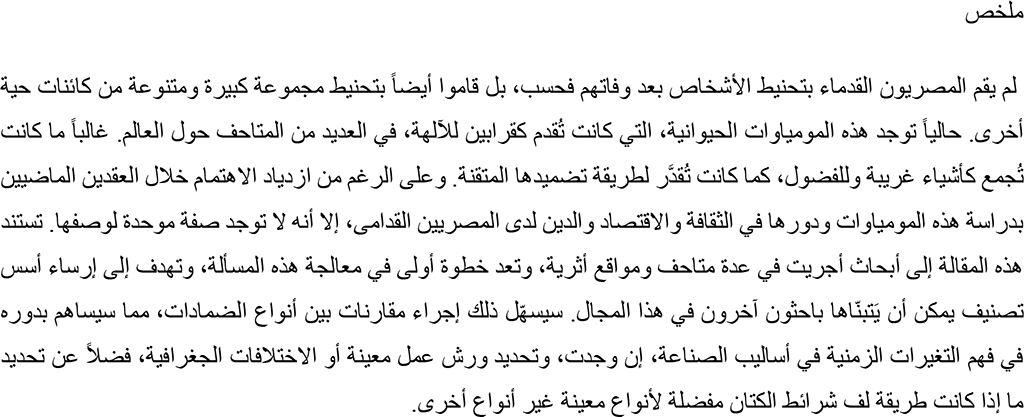
Subsequent attention to animal mummies was incidental, save for work carried out at Tuna el-Gebel, starting in the 1980s, under the direction of Dieter Kessler, later joined by Abdel Halim Nur-el-Din. This project focussed on the study of animal cults at that site and involved archaeologists, epigraphers, and archaeozoologists, resulting in a series of publications.6 Although attempts were made to adopt a similar holistic approach at the Sacred Animal Necropolis at Saqqara – excavated initially under the direction of Walter B. Emery,7 and subsequently by Harry Smith8 – the archaeozoological component was not comprehensive. Recently, sizeable volumes containing a wealth of textual and archaeological information from the work at North Saqqara have been published,9 but the materials presented on the animal remains are few, with the bulk still pending. After a significant hiatus in time, the 1990s brought an upsurge in interest in animal mummies due to the work of Alain Charron10 in France and Salima Ikram11 in Egypt. This was enhanced by the reinstallation of the Animal Mummy Room in the Egyptian Museum and attendant publicity in the press.12 In the last two decades there has been a marked increase of scholarly attention to animal mummies, including in museum catalogues, excavation reports, and articles on individual case studies or groups of mummies.13
Publications of animal mummies, particularly museum catalogues that contain examples of the most beautifully wrapped and well-preserved mummies, have clearly shown that there is a need for some degree of standardisation in animal mummy studies, most notably in the description of their wrappings, as the terms used to describe these vary considerably (diamond/lozenge; check/basket, etc.), making it difficult to make comparisons, particularly without a photograph. Animal mummies display an unparalleled wealth of wrapping styles, going from simple spiral bandaging to intricate polychrome basketry-weave patterns. A close study of these might allow for their dating and for the identification of ateliers or geographic origins. If any patterns can be established, this would be particularly useful for museums, as so many animal mummies in museum collections are unprovenanced. A large-scale examination of animal mummies from known as well as unknown sites might not only provide provenance, but also shed light on patterns of production. Thus, this article is an initial step in addressing the issue of bandaging nomenclature. It aims at laying the foundations of a typology that may be adopted by other scholars in the field and at facilitating comparisons in bandage descriptions that will contribute to our understanding of diachronic change in styles, if any.14 In addition to the identification of specific ateliers or geographic variations, this work will possibly help recognize whether specific styles of wrapping were favoured for particular species. For example, it appears thus far that the polychrome bandaging of cats with painted-on facial details, including mask-like eyes, originates from Stabl Antar, near Beni Hasan (see Subtype B1), while cats wrapped as if they were standing or walking originate from the Bubasteion at Saqqara (see Subtype A6),15 and mummiform or teardrop-shaped ibises with modelled heads tend to originate from Abydos (see Fig. 50). There is also a preponderance of appliqués on the bird mummies from Saqqara (see Subtype A8). The identification of the patterns and their nomenclature presented here is the result of the work of a group of scholars with different specialties (Egyptology, archaeology, museology, archaeozoology, textiles, and conservation) who have examined large collections of animal mummies from excavations in Egypt and from museum collections in Egypt, the United States, Europe and the United Kingdom. This study emphasises the importance of museum collections and collaborative work.
1. Methodology and basis of our typology
Our typology was created based on a survey of the wrappings on animal mummies in a number of museum collections, including the Museo Egizio (Turin), the Egyptian Museum (Cairo), the British Museum (London), the Louvre (Paris), the Natural History Museum of the Smithsonian Institution
The criteria were selected on the basis of an analysis of the external appearance of the wrappings and the patterns, and the technology that was used to create them.16 It therefore leaves aside creatures completely encased in cartonnage, such as ibis mummy CG 29874 and baby crocodile CG 29816 bis (Fig. 1).
Mummy of a crocodile (Cairo CG 29816). L. 26.6 cm, W. 5.75 cm. Photo: ©Egyptian Museum, Cairo, Animal Mummy Project. Photo by Anna-Marie Kellen.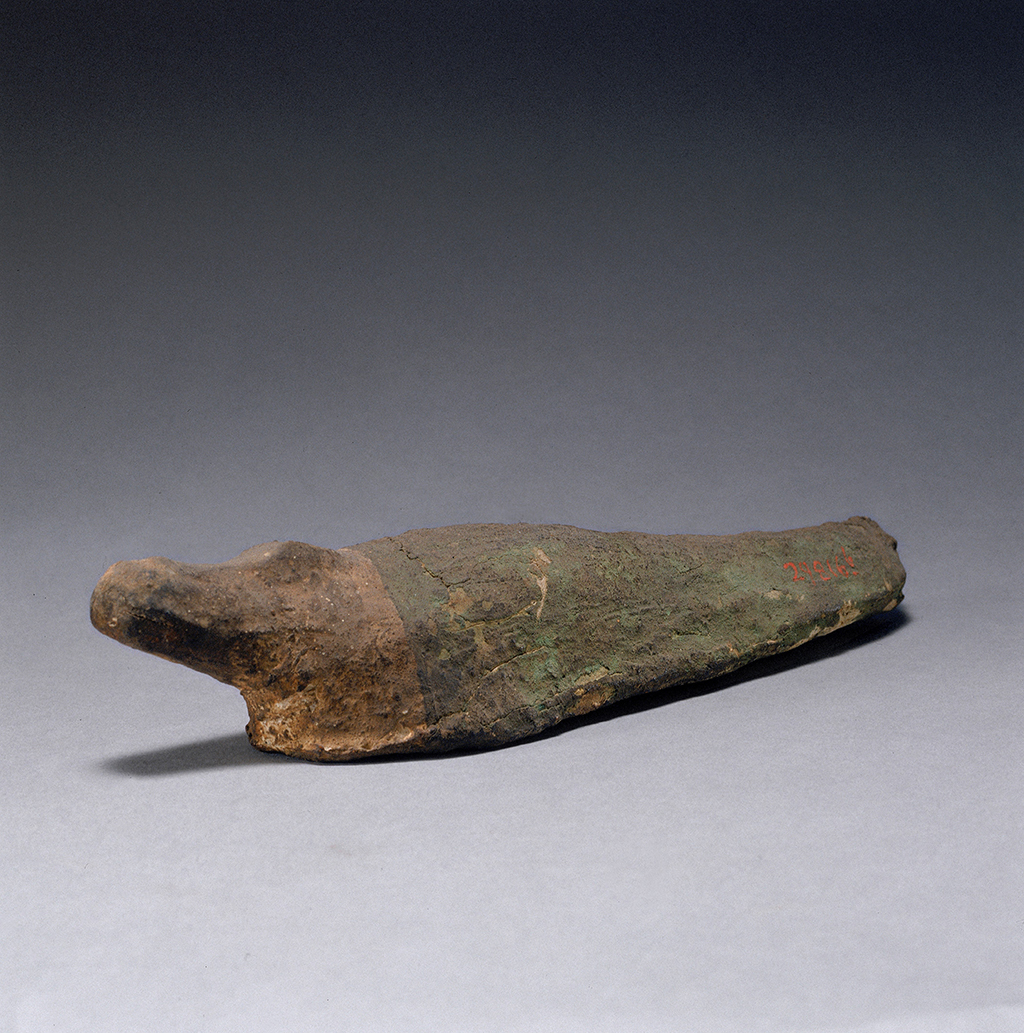
It should also be noted that the typology presented here does not focus particularly on specific variations on the faces of the mummies, as these tend to be painted, modelled or appliquéd, or a combination thereof, and are thus preferably described individually. The typology excludes the wrappings for victual food mummies as these are a different category of mummy from the votive animals that are the focus of this paper.17 Victual mummies, most commonly found in Dynasty 18, consist of cuts of meat and entire birds prepared and ready to be eaten, and are almost invariably spirally wrapped.
2. Challenges
Mummy of a cat (Cairo CG 29655). L. 30 cm, W. 7 cm. Photo: ©Egyptian Museum, Cairo, Animal Mummy Project. Photo by Anna-Marie Kellen.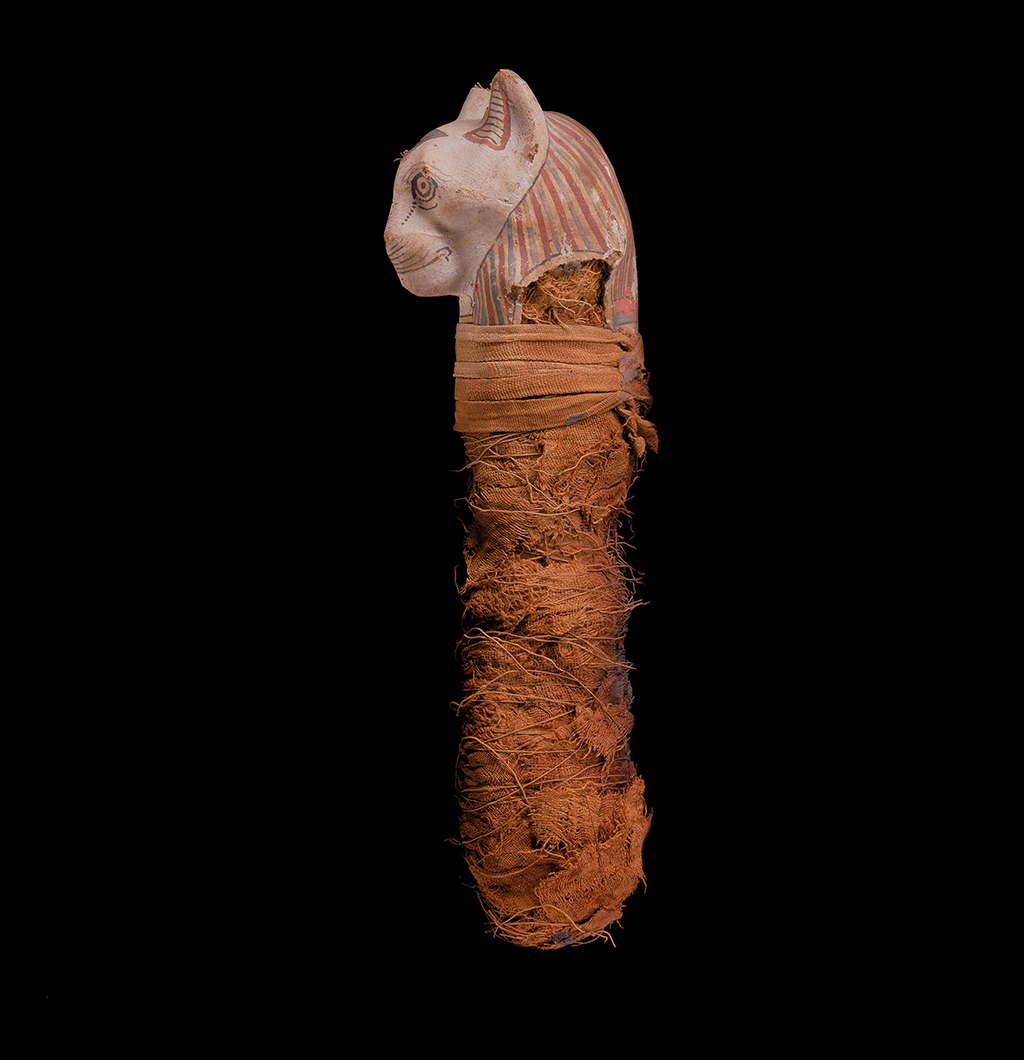
For example, it is not totally clear if the subtype called here “Plain with Contrasting Coloured Bands” (Subtype A7, Turin C. 2350/6) was originally thus, or if portions fell off in antiquity, leaving the current pattern. Often haphazard bandaging covered by a loose lashing of linen thread is a lower layer of bandaging and not meant to be the final product. Even spiral wrapping is not necessarily the final visible layer that was for show. It should therefore be remembered that there are often instances where the dyes of bandages have faded, or pieces of linen (particularly when dyed dark brown) have fallen off, thereby altering the wrapping pattern. In other cases,
Also, it should be noted that combinations of different styles, for example spirals and coffers, can be used on the same mummy bundle. This is particularly true when tails are involved. A few examples of such combinations can be seen in Subtype C3, with a polychrome chevron twill interweaving (CG 29866) and coffers over the body with spirals around the tail (Fig. 3).
a. Mummy of a crocodile (British Museum EA 37347). L. 94 cm; b. Detail of the tail with spiral bandages. Photos: ©Trustees of the British Museum.
Another even more extreme example is cat Louvre E 2811, with a spiral on the head, basket weave on the neck, a triangular motif on shoulder and base, and a mix of rectangular and diamond coffers on the body (Fig. 4).
Mummy of a cat (Louvre E 2811). L. 59 cm, W. 9 cm. Photo: ©2004 Musée du Louvre. Photo by Christian Décamps.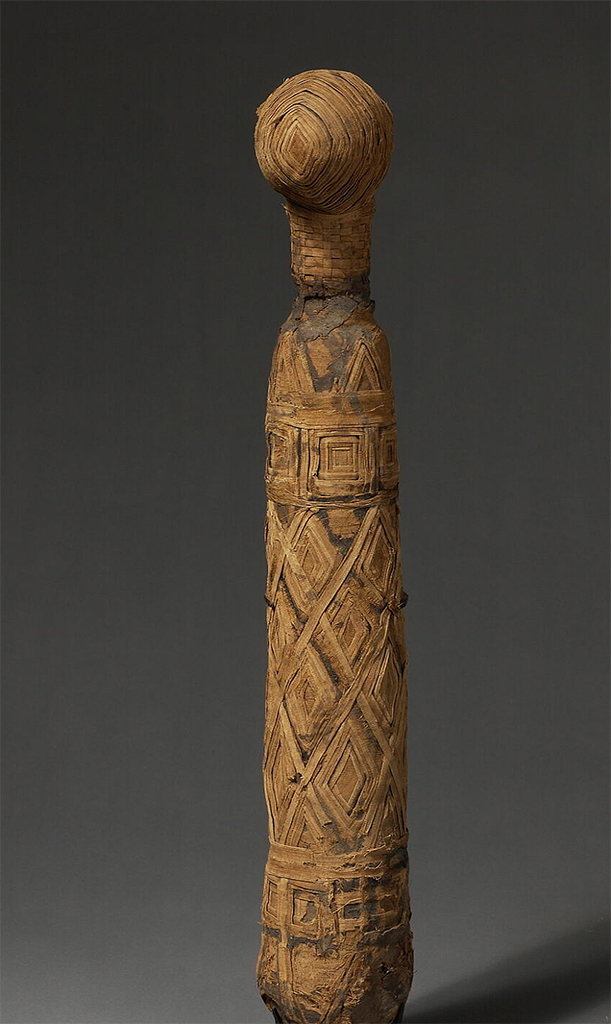
In these instances, one can describe each pattern and identify where it is located on the animal’s body. It should be remembered that in many cases, while the front of the mummy is well decorated, the back can be plain or cursorily wrapped, allowing us to learn how it was produced. In some instances, there are indications of re-wrapping of damaged mummies in antiquity, which further confuses the issue. Such cases were noted, for example, on bird mummies from Theban Tombs 11, 12, and 366.18
There are also unique examples of wrapping styles, which are not given a place in our typology proper as only single instances of these are attested – if other similar specimens come to light, they can be added at a later date. Examples of unique wrappings include an elaborately wrapped cat mummy in the British Museum (EA 55409), which is unusual in that it has a cloth rosette, consisting of concentric rings of textile, attached to its base (Fig. 5). At present, this refinement is only known from this mummy, although it was certainly used on others.
Bottom view of the mummy of a cat (British Museum EA 55409). H. 42.8 cm. Photo: ©Trustees of the British Museum.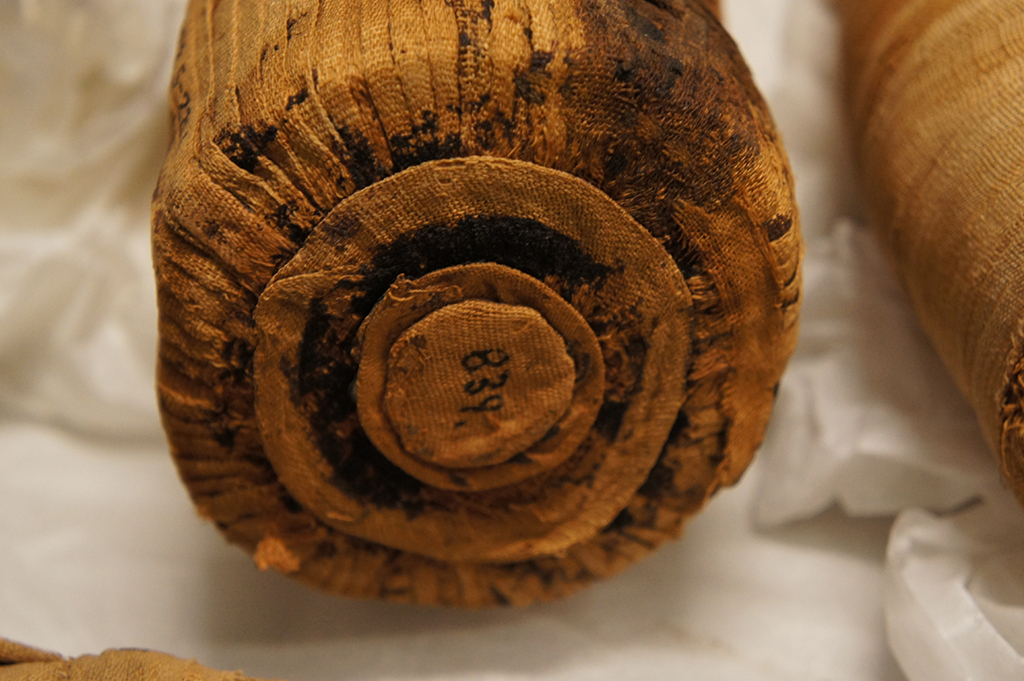
Another example is a cat mummy from Turin (Turin, Museo Egizio, C. 2350/6) whose head is covered with a plain piece of cloth, and the body with another such piece, with the two meeting at the neck. Two strips of bandage dyed a dark brown are tied around the head horizontally. Another similar pair of bandages are tied around the body at the
Cat mummy (Turin, Museo Egizio, C. 2350/6). L. 27 cm. Provenance unknown. 400-50 BC (14C of the textile). Photo: Museo Egizio, Turin.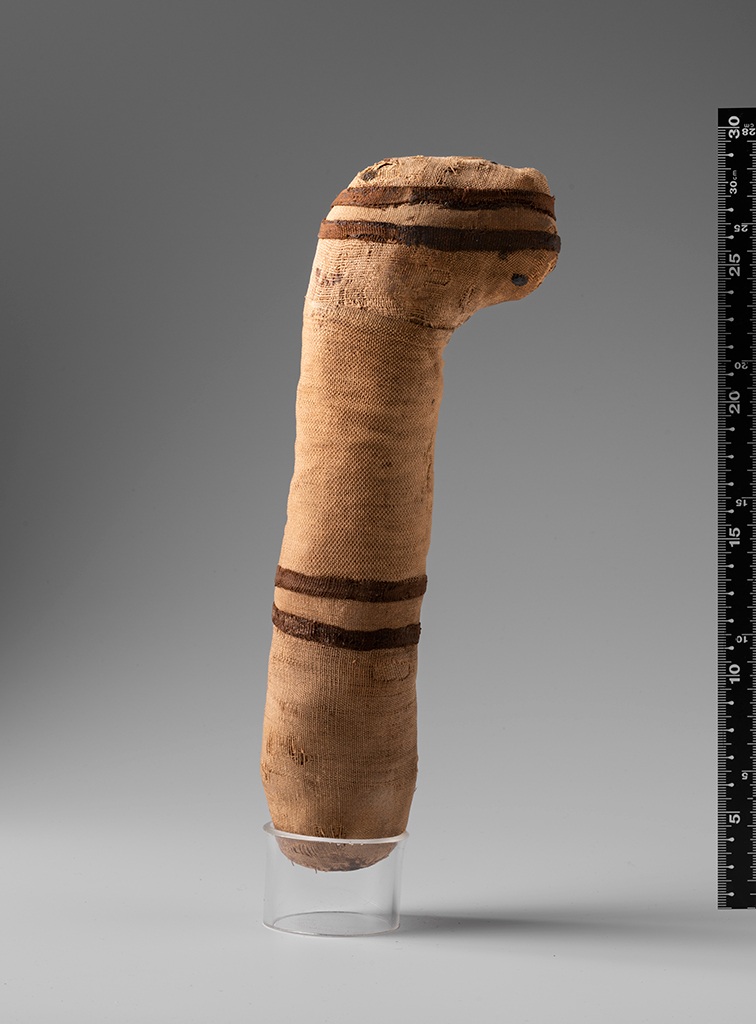
In addition, a group of fish mummies should be noted here. These are unlike the other mummies as their outermost wrapping seems to consist of vegetal material, often strips of papyrus (Subtype A5),19 which are often observed on other mummies – most notably of gazelles – within layers that are usually not visible, and are most regularly covered with at least a piece of textile.20 The fact that this does not seem to be the case for this group of fish stresses once more that the expected outer appearance of these mummies can vary greatly.
As already mentioned, there is no doubt that the typology presented here is not exhaustive, but it can always be edited or added to as new finds come to light. This typology should be a useful tool for scholars working on animal mummies as it will allow for easy comparison of different data sets, and thus contribute to a better understanding of whether certain styles of wrapping were reserved for particular creatures or groups of animals, associated with a particular deity, or could be ascribed to a certain time period or area. It is hoped that scholars working in animal mummy studies will adopt the terms laid out below.21
3. A typology of bandage patterns for animal mummies
3.1. Type A – Plain fabric
Both the outer fabric and/or decorative elements are frequently held in place by resinous dots, where necessary to maintain the correct mechanical tension. Stitches are not used.
The types present the different means by which the fabric is held in place, with bandages, wraps, linen threads or plant fibre strings, or/and is decorated in various ways with appliqués, dyed bandages, a net pattern, etc.
- ● Subtype A1: plain fabric
- ● Subtype A2: plain fabric with edging bandage
- ● Subtype A3: plain fabric with asterisk pattern
- ● Subtype A4: plain fabric kept in place by linen threads
- ● Subtype A5: plain fabric kept in place by vegetal strips
- ● Subtype A6: plain fabric with horizontal and/or vertical decorative bands
- ● Subtype A7: plain fabric with appliqué
- ● Subtype A8: plain fabric with painted decoration
- ● Subtype A9: plain fabric with criss-crossed bandages
- ● Subtype A10: plain fabric with a net pattern and horizontal bands
- ● Subtype A11: plain fabric with a net pattern reinforced by criss-crossed dyed bandages.
Subtype A1 – Plain fabric
The fabric used is plain, usually undyed and undecorated. More than one piece of fabric can be used to cover the external surface. Dots of resinous material are often used to secure the fabric to the surface (Fig. 7).
English: Plain fabric.
Ibis mummy (London, British Museum, EA 13052). L. 36.7 cm. Provenance and date unknown. Photo: ©The Trustees of the British Museum.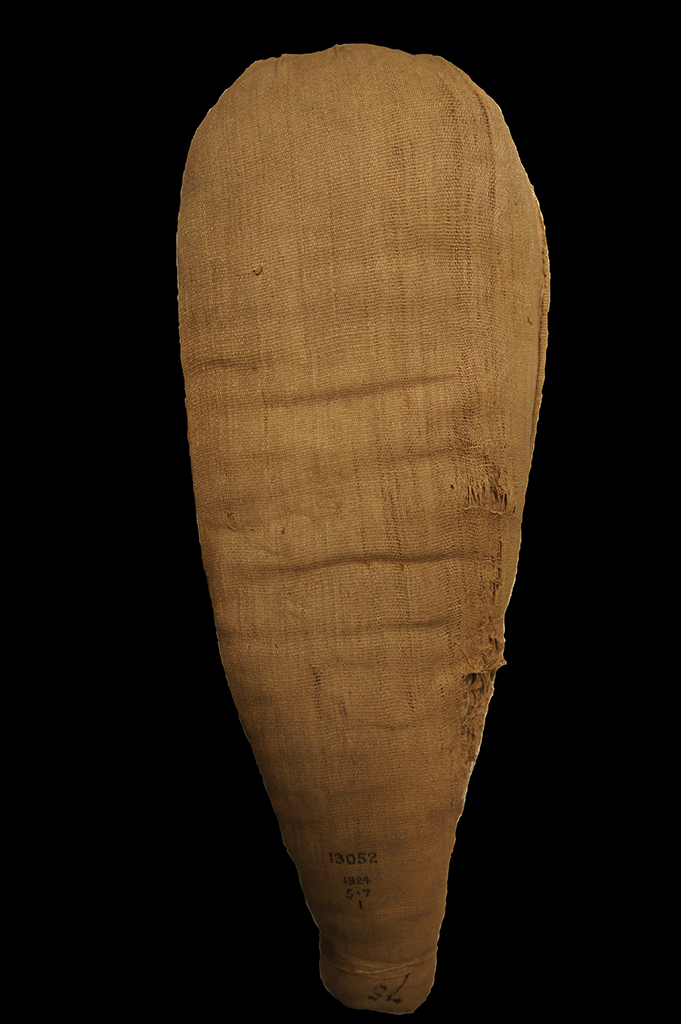
Subtype A2 – Plain fabric with edging bandage
The packages can be circular, rectangular, oval or square with an edging bandage. This pattern is usually found on shrews (Fig. 8) and snakes (Fig. 9).
English: Plain fabric with edging bandage.
Shrew mummy (Djehuty Project, no. 6492). L. 7 cm; a. Top view; b. Bottom view. TT11-TT12, Dra Abul Naga, Thebes. Ptolemaic period, possibly reign of Ptolemy V. Photo by Salima Ikram, courtesy Proyecto Djehuty.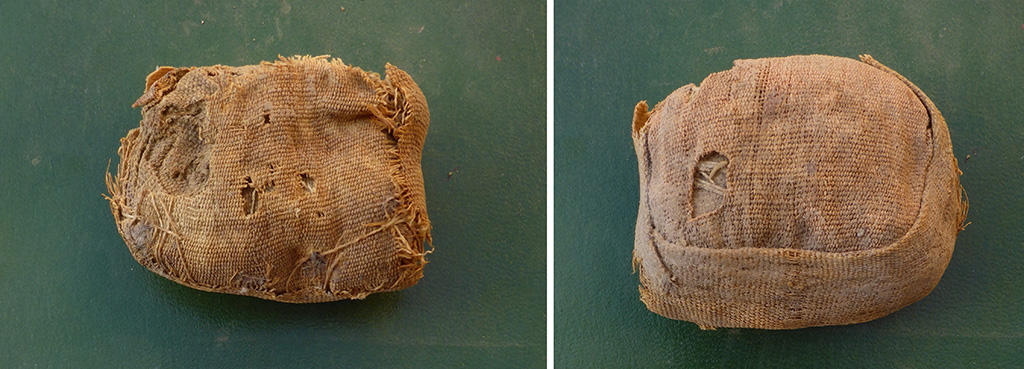
Snake mummy (Turin, Museo Egizio, P. 1515/2). L. 12 cm, W. 7.5 cm. Provenance unknown. 360-200 BC (14C of the textile). Photo: Museo Egizio, Turin.
This pattern is usually found on the top of small packages containing snakes, though it might be used for other reptiles (Fig. 10).
English: Plain fabric with asterisk pattern.
Reptile mummy (London, British Museum, EA 52921). D. 8.5 cm. Abydos. Ptolemaic Period. Photo: ©The Trustees of the British Museum.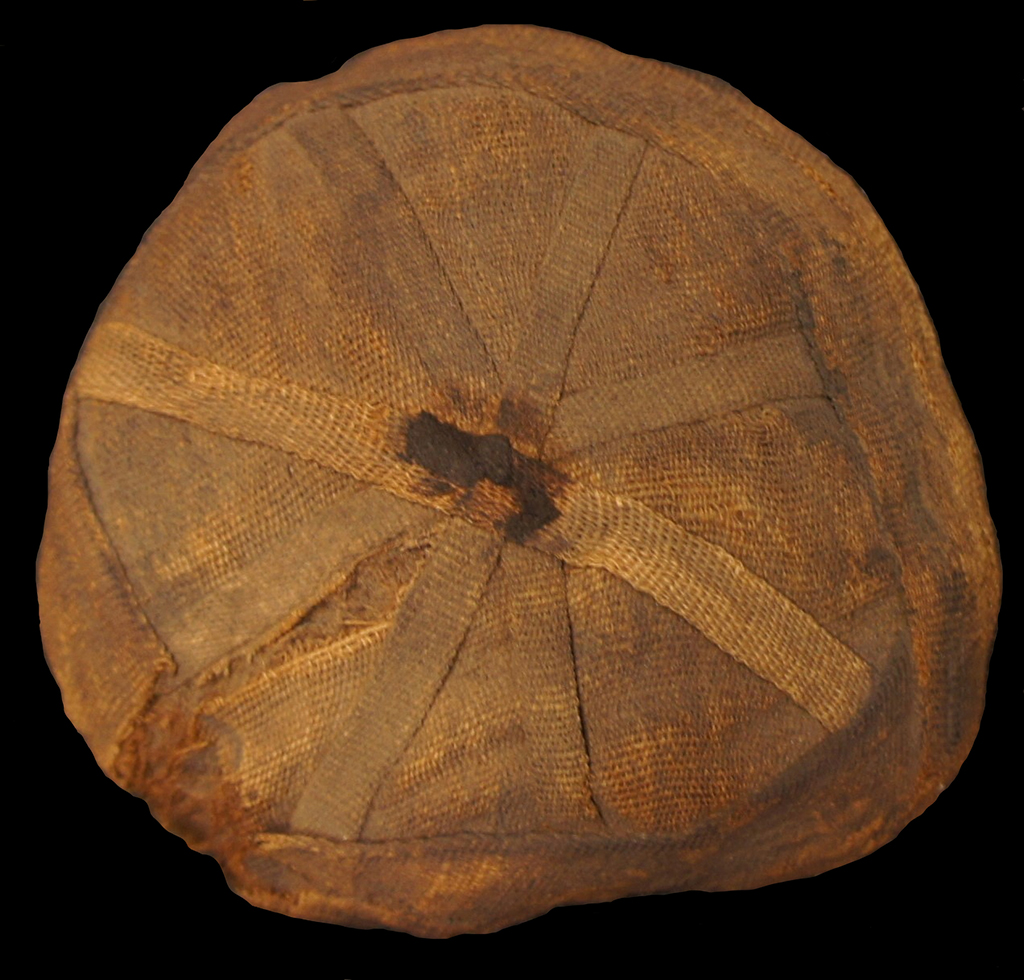
Subtype A4 – Plain fabric secured by linen threads
This kind of wrapping is usually found on young crocodiles (Fig. 11).
English: Plain fabric kept in place by linen threads.
Crocodile mummy (Turin, Museo Egizio, P. 1458/12). L. 27.5 cm, W. 4.5 cm. Provenance unknown. 210-40 BC (14C of the textile). Photo: Museo Egizio, Turin.
Subtype A5 – Plain fabric secured by vegetal strips
This mode of wrapping is usually found on fish (Fig. 12).
English: Plain fabric kept in place by vegetal strips.
Fish mummy (Turin, Museo Egizio, S. 19691/3). L. 28 cm, W. 10 cm. Provenance and date unknown. Photo: Museo Egizio, Turin.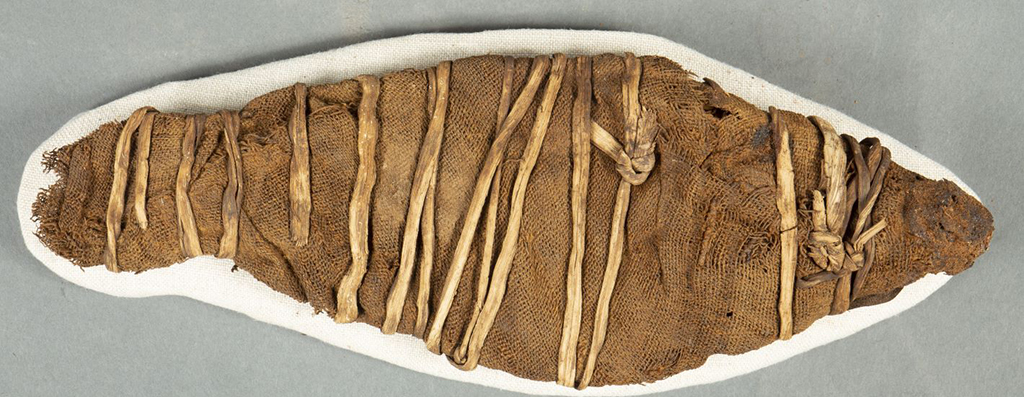
Subtype A6 – Plain fabric with horizontal and/or vertical bands
This pattern is usually found on cats; several examples were discovered in 2019 inside a large cache of mummified animals at the Bubasteion at Saqqara.22 The legs are often found spirally wrapped, and in some cases the hindlegs and tail are then tied together, which can also be done with the forelegs (Fig. 13).
English: Plain fabric with horizontal and/or vertical decorative bands.
Cat mummy (Sharm el-Sheikh Museum, number pending). L. 36 cm. Bubasteion, Saqqara. Probably Ptolemaic Period. Photo: ©Ministry of Tourism and Antiquities’ Press Office. Photo by Ayman Damarany.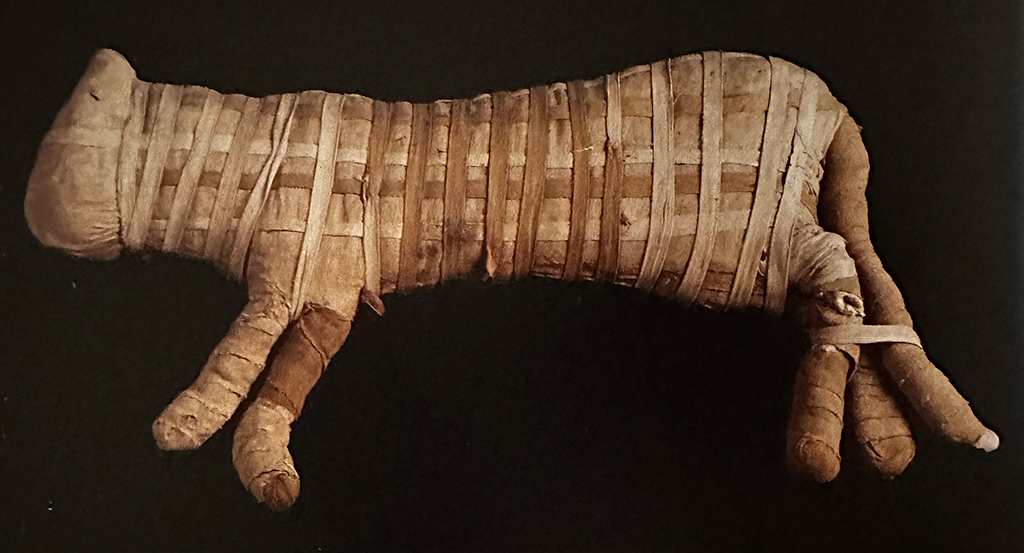
Subtype A7 – Plain fabric with appliqué
English: Plain fabric with appliqué.
Mummy bundle from the Ibis Catacombs (Cairo, Egyptian Museum, CG 29692). L. 39 cm. Saqqara. Date unknown. Photo: ©Egyptian Museum, Cairo, Animal Mummy Project. Photo by Anna-Marie Kellen.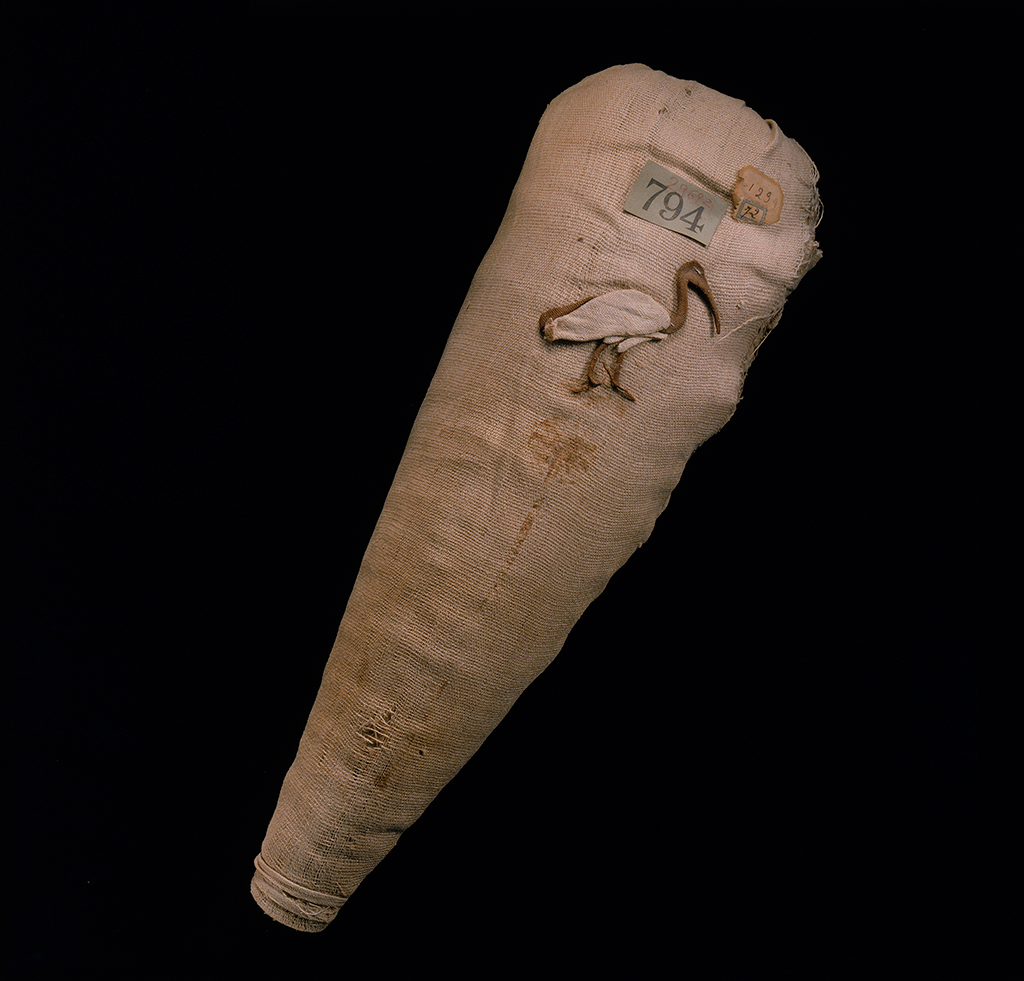
Subtype A8 – Plain fabric with painted decoration
The mummy bundle is covered with a plain piece of textile that is then enhanced with a painted decoration (Fig. 15).
English: Plain fabric with painted decoration.
Ibis mummy (New York, Metropolitan Museum of Art, 90.6.109). L. 40.5 cm. Saqqara. Date unknown. Photo: ©The Metropolitan Museum of Art, New York.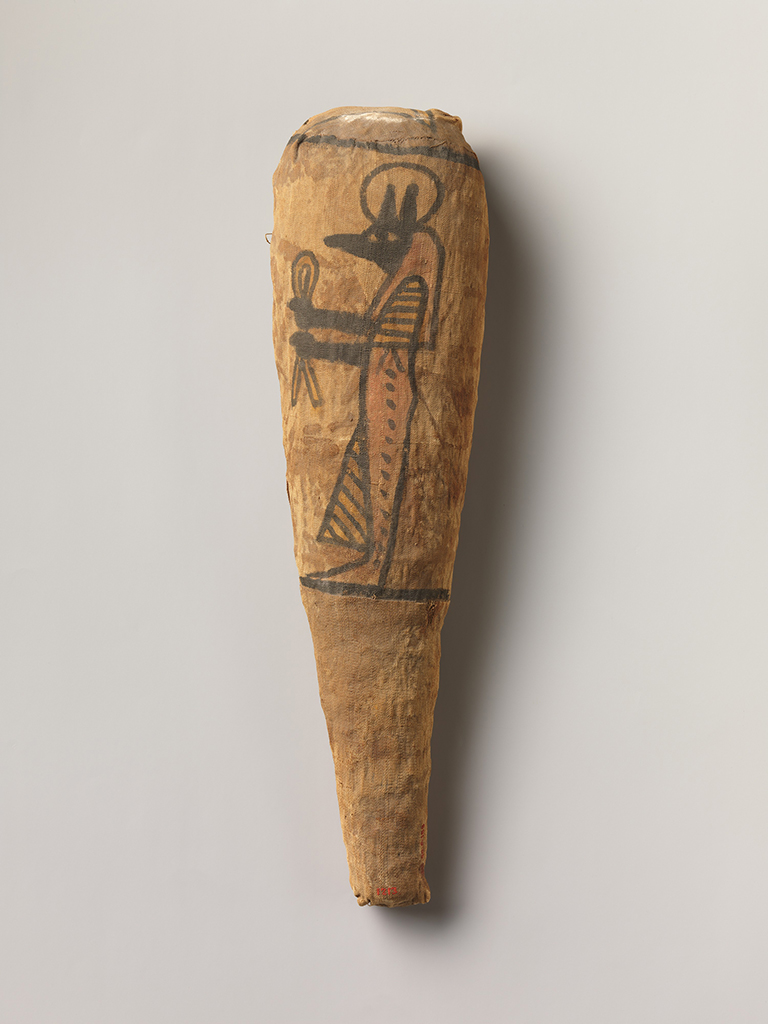
This pattern is usually found on raptors (Fig. 16).
English: Plain fabric with vertical bands with superimposed diagonal and horizontal bandages.
Raptor mummy (Cairo, Egyptian Museum, CG 29682). L. 39.5 cm. Perhaps Saqqara. Date suggested: 2nd–4th century AD. Photo: ©Egyptian Museum, Cairo, Animal Mummy Project. Photo by Anna-Marie Kellen.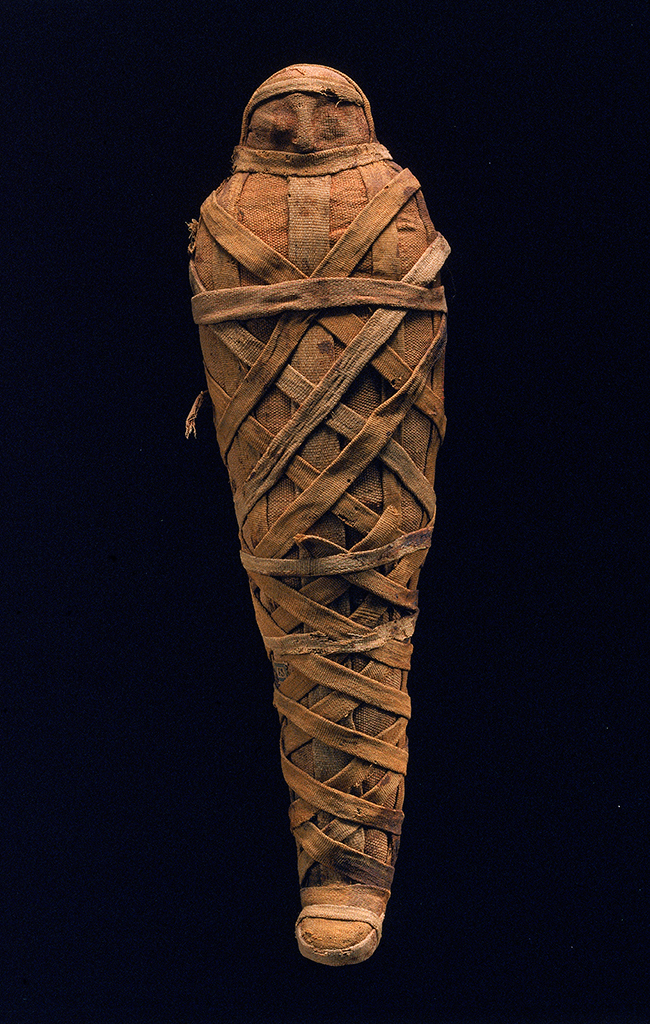
This kind of decoration is found on the ventral side of animals (the front of cats) (Fig. 17) or over the whole surface of conical-shaped ibis mummies (Fig. 18).
English: Plain fabric with a net pattern over coloured horizontal bands.
Cat mummy (Turin, Museo Egizio, C. 2348/2). L. 54 cm. Provenance unknown. Probably Late Period – Ptolemaic Period. Photos: Museo Egizio, Turin. Pattern drawing of the side view by Valentina Poletto.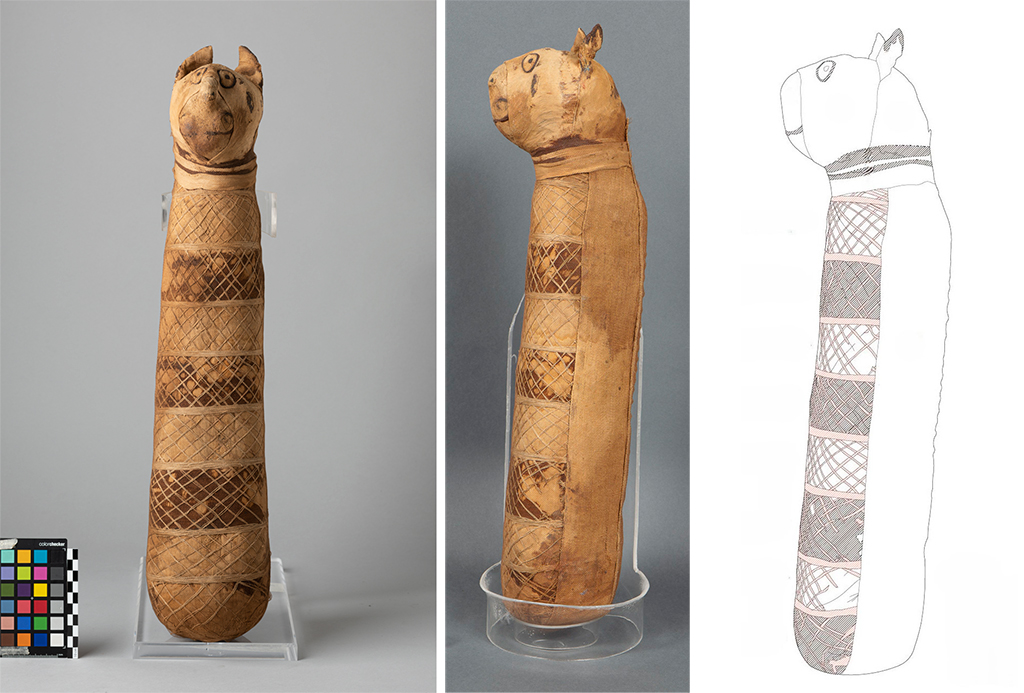
Ibis mummy (Cairo, Egyptian Museum, CG 29873). L. 39 cm. Saqqara. Date unknown. Photo: ©Egyptian Museum, Cairo, Animal Mummy Project. Photo by Anna-Marie Kellen.
Subtype A11 – Plain fabric reinforced by a net pattern and criss-crossed dued bandages
English: Plain fabric with net pattern and criss-crossed reinforcing bands.
Cat mummy (London, British Museum, EA 6756). L. 49.5 cm. Provenance and date unknown. Photo: ©The Trustees of the British Museum.
3.2. Type B – Overlapping bandages in a spiral motif
In the herringbone patterns (Subtypes B4–B6), the sides and base of the animal are often protected by pieces of fabric, which cannot be strictly considered part of the decorative pattern.
The types (numbered in sequence) are identified according to the way that the bandages are wrapped around the body and the resulting pattern.
- ● Subtype B1: spiral
- ● Subtype B2: monochrome herringbone
- ● Subtype B3: polychrome herringbone
- ● Subtype B4: herringbone with appliqué
- ● Subtype B5: herringbone in a diamond pattern
- ● Subtype B6: herringbone with small or large insets.
The decorative pattern is made by overlapping bandages (often with just one side folded in upon itself) that envelop the body in a series of spirals. Alternating undyed and dyed textiles are frequently observed. The spiral can have an “S” or “Z” direction. The bandages are kept in place by the overlap of the subsequent coil of the bandages, sometimes reinforced by dots of resinous material.
This kind of pattern is usually found in mummies that are cylindrical or skittle-shaped (cats, dogs) (Fig. 20). The pattern can also be combined with other types of wrappings in larger animals (it is used to decorate the tails of crocodiles, for example).
English: Mono-/polychrome spiral.
Cat mummy (London, British Museum, EA 65502). L. 39 cm. Provenance and date unknown; This particular design on cats, with its characteristic painted face, however, seems to originate from Stabl Antar. Photo: ©The Trustees of the British Museum.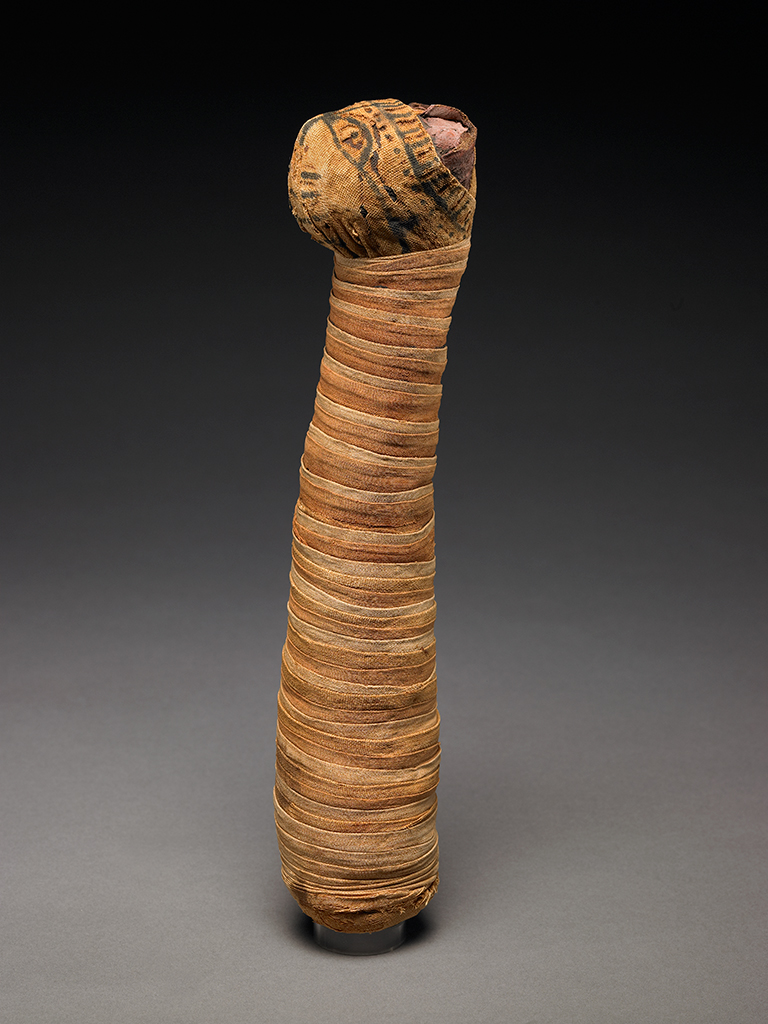
This type of wrapping is frequently observed on a variety of animals (cat, dog, raptor, ibis, etc.) whose mummies are elongated or look like human mummies (Fig. 21).
English: Monochrome herringbone.
Raptor mummy (London, British Museum, EA 68006). H. 40 cm. Saqqara. Date unknown. Photo: ©The Trustees of the British Museum.
This type of wrapping is found on many animals (cat, dog, raptor, ibis, etc.), and in mummy bundles that can be stood upright (Fig. 22).
English: Polychrome herringbone.
Cat mummy (Turin, Museo Egizio, C. 2349/4). L. 30.2 cm. Provenance and date unknown. Photo: Museo Egizio, Turin. Pattern drawing by Valentina Poletto.
This type of wrapping is most frequently observed on birds (Fig. 23)
English: Herringbone with appliqué.
Ibis mummy (London, British Museum, EA 67149). L. 47 cm. Saqqara. Date unknown. Photo: ©The Trustees of the British Museum.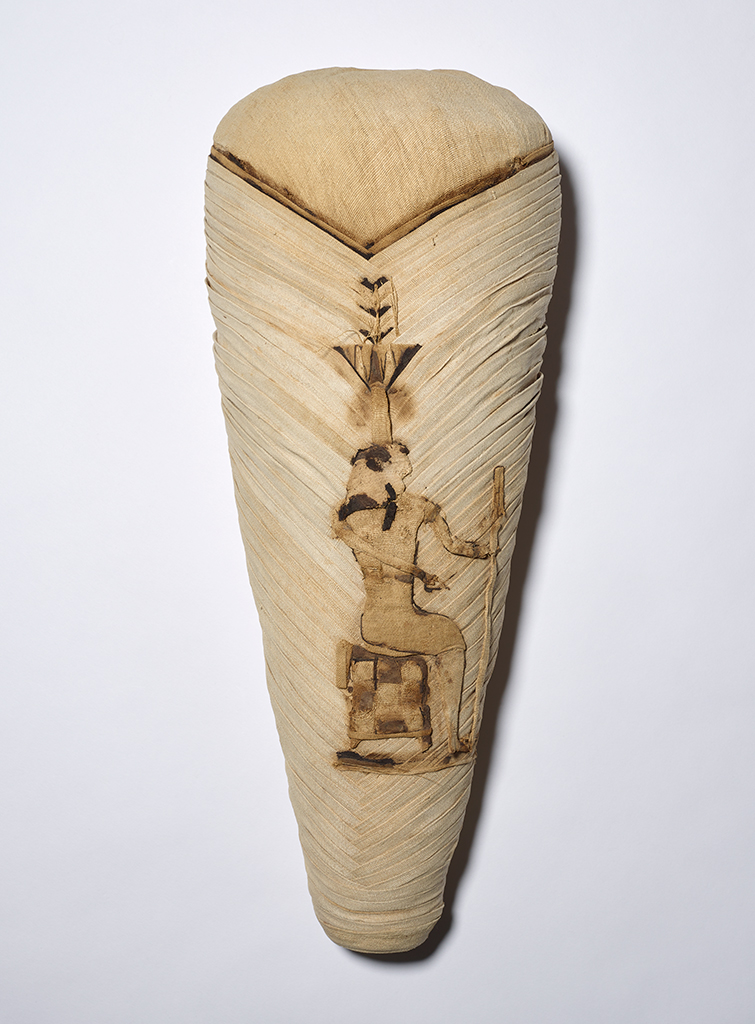
This type of wrapping is frequently observed in elongated mummy bundles and is used primarily on birds (Fig. 24), but cats23 are also known (Fig. 25).
English: Herringbone in a diamond pattern.
Ibis mummy (London, British Museum, EA 68219). L. 42 cm. Saqqara. Date unknown. Photo: ©The Trustees of the British Museum.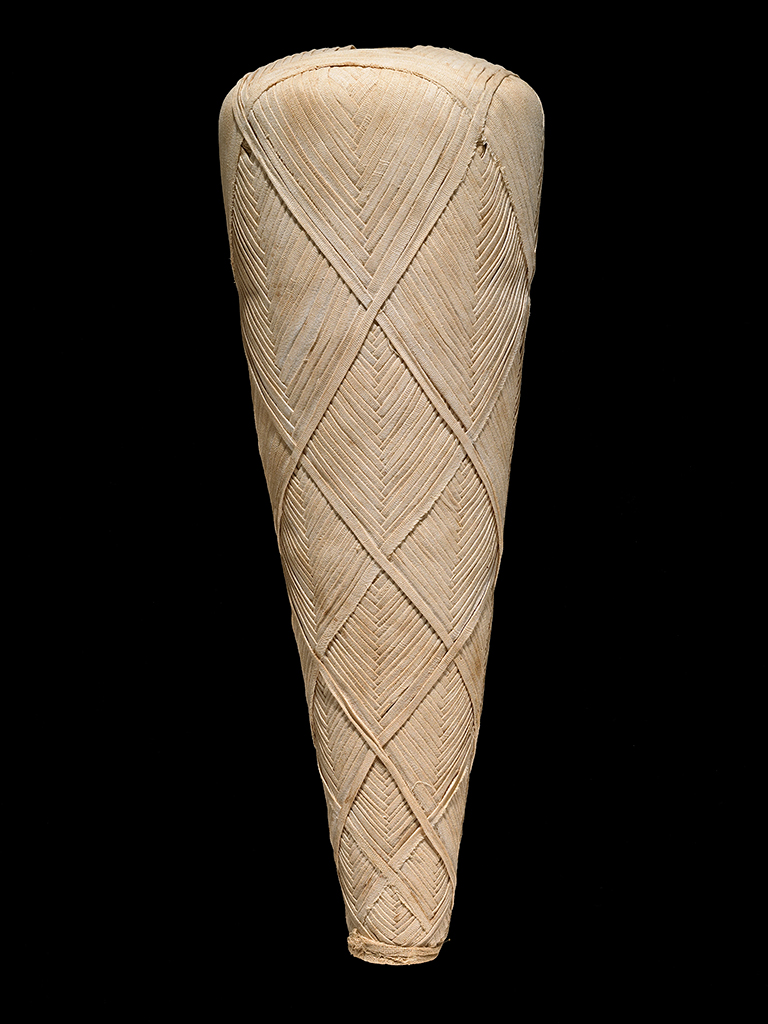
Cat mummy (Naples, S.A.I., Museo Scerrato, 68). L. 54.5 cm. Provenance unknown. 390-340 BC (14C of the textile). Photo from Stéphanie Porcier et al. (eds.), Creatures of Earth, 2019, p. 298, fig. 6.
Subtype B6 – Herringbone with small or large insets
This type of wrapping is frequently observed on ibis mummies positioned with the animal lying on its back with the beak resting on its ventral side and the legs drawn up to the body.
English: Herringbone with undyed and polychrome bandages with insets.
Ibis mummy (Turin, Museo Egizio, S. 8189). L. 31 cm, W. 7.8 cm. Asyut. Probably 5th to 1st century BC. Photo: Museo Egizio, Turin. Pattern drawing by Valentina Poletto.
Ibis mummy (Turin, Museo Egizio, S. 8188). L. 34 cm, W. 12.4 cm. Asyut. Probably 5th to 1st century BC. Photo: Museo Egizio, Turin.
3.3. Type C – Simple orthogonal interweaving
The final effect of the design is enhanced by the use of bandages dyed in different colours, kept under tension and in place by dots of resinous material. There is no stitching.
Generally, this type of decoration is found on the ventral side of smaller animals (dogs, cats, birds of prey) or on the dorsal side of bigger ones, like crocodiles.
The types (numbered in sequence) are identified according to the way the bandages are interwoven:
- ● Subtype C1: monochrome tabby interweaving
- ● Subtype C2: polychrome tabby interweaving
- ● Subtype C3: polychrome chevron twill interweaving
- ● Subtype C4: polychrome crenellated interweaving.
Subtype C1 – Monochrome tabby interweaving
The pattern is executed through the orthogonal interweaving of undyed vertical and horizontal bandages (with the edges folded on both sides) in the same way as a tabby weave (Fig. 28).
English: Monochrome tabby plaiting.
Cat mummy (Paris, Louvre, N 3505). L. 99 cm. Provenance unknown. Graeco-Roman period. Photo: ©2004 Musée du Louvre. Photo by Christian Décamps.
The interweaving of brown-dyed vertical bandages and undyed horizontal bandages produces a chessboard pattern (Fig. 29).
English: Polychrome tabby weave with chessboard pattern.
Dog mummy (New York, Metropolitan Museum of Art, 13.182.50). L. 28 cm. El-Deir, Kharga. Date unknown. Photo: ©The Metropolitan Museum of Art, New York.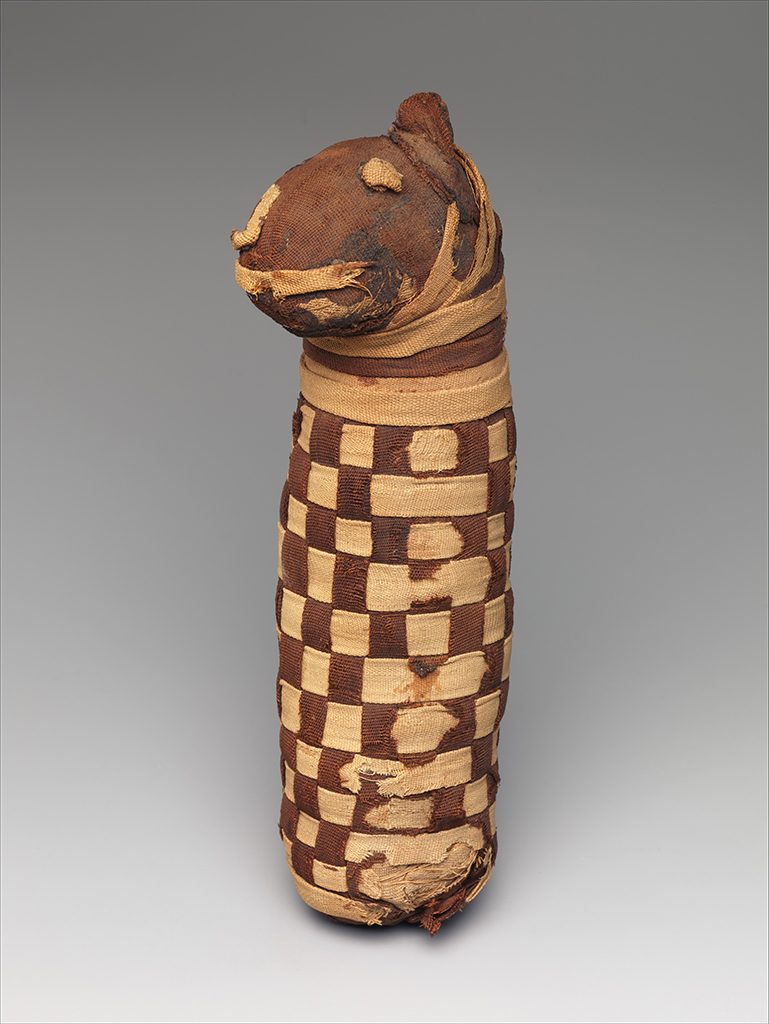
Subtype C3 – Polychrome chevron twill interweaving
This type of wrapping is found on birds (Fig. 30) and cats (Fig. 31).
English: Polychrome chevron twill plait with a V-shaped motif.
Ibis mummy (Cairo, Egyptian Museum, CG 29866). L. 37 cm, W. 4.5-12.2 cm. Abydos. Possibly Ptolemaic. Photo: ©Egyptian Museum, Cairo, Animal Mummy Project. Photo by Anna-Marie Kellen.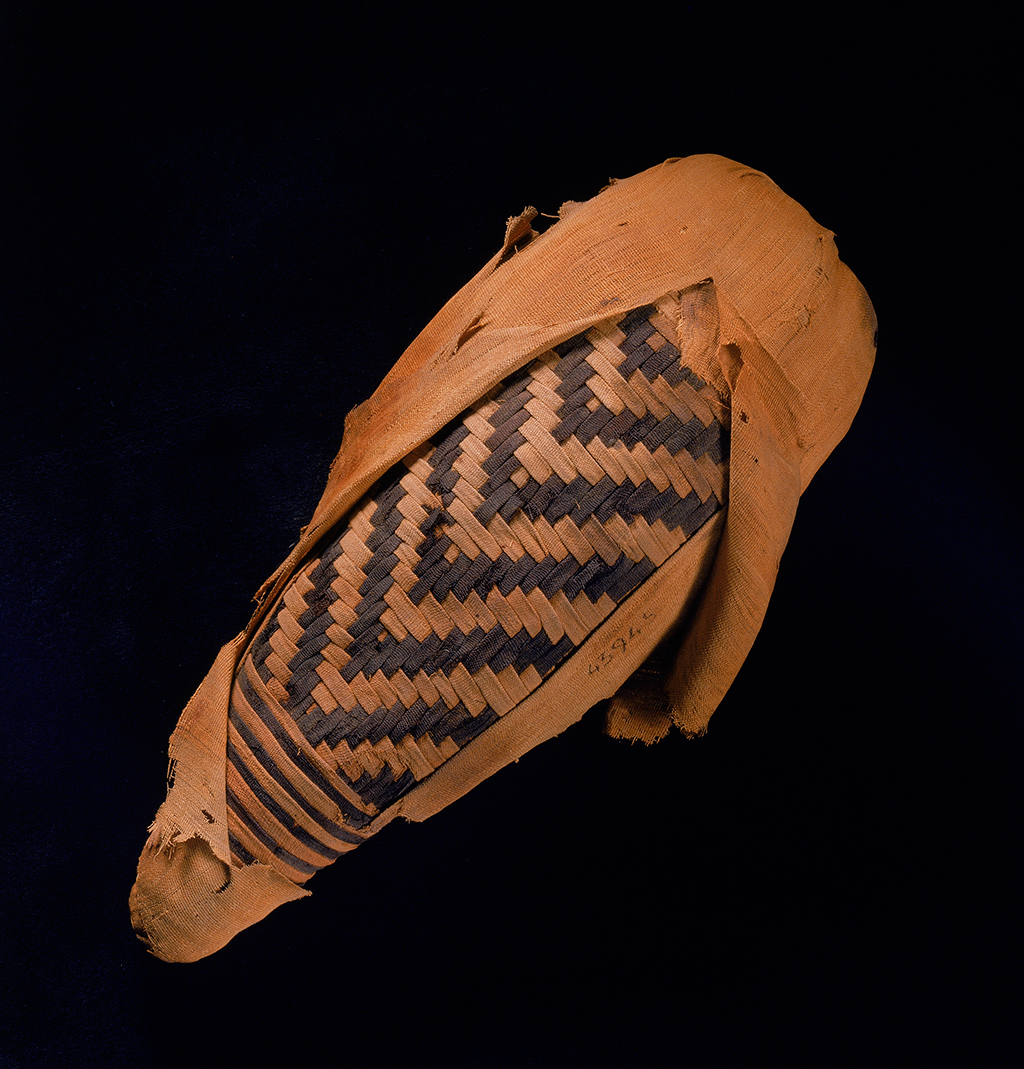
Cat mummy (Turin, Museo Egizio, C. 2349/1, L: 30.3 cm). Provenance and date unknown. Photo: Museo Egizio, Turin. Pattern drawing by Valentina Poletto.
This type of decoration can be found on the ventral side of cat mummies (Fig. 32) and around ibis mummies.
English: Polychrome crenellated interweaving.
Cat mummy (British Museum EA 37348). L. 46 cm. Abydos. Date unknown. Photo: ©Trustees of the British Museum.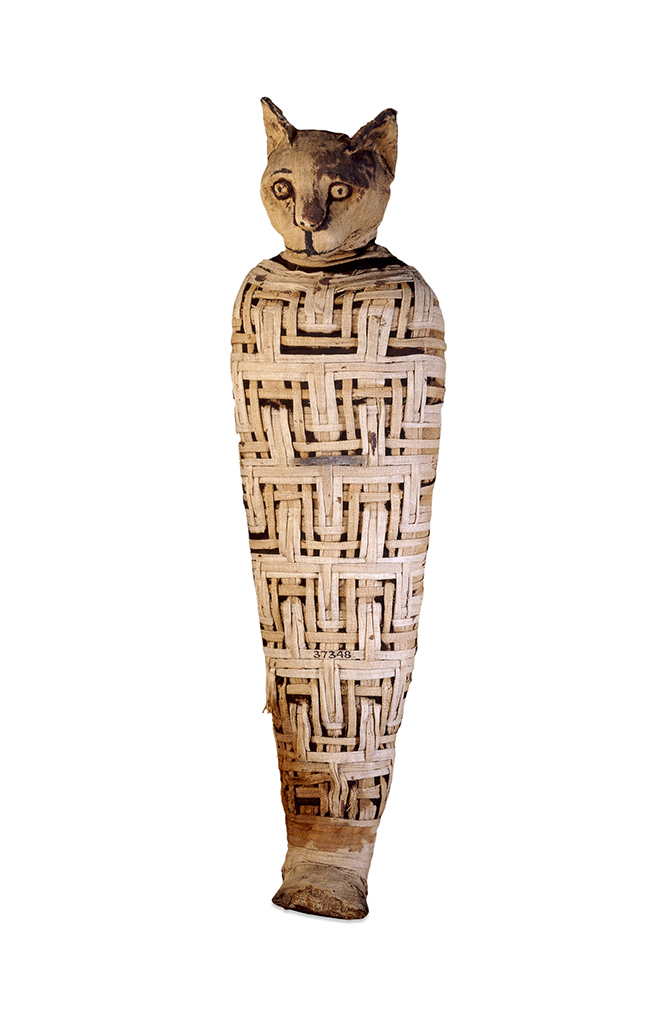
3.4. Type D – Coffers (complex ortogonal interweaving)
Each coffer is framed and separated from adjacent ones by a bandage (folded on both sides), sometimes in a contrasting colour, which serves both to enhance the design and to structurally maintain the decoration in place. Many of these “framing” bandages have disintegrated over time, as they were not woven into the structure and were originally only stuck in place by a resinous substance.
The types are identified according to the final visual pattern obtained through the interweaving of differently coloured bandages. The description/definition of each pattern is based on the visual effect of the surviving dark-coloured elements. Relying on any other dyed elements (not brown), which may be discoloured/faded, would be too unreliable at the present stage of research. This is a methodological choice, but a necessary one in order to establish our typology.
- ● Subtype D1: simple coffer
- ● Subtype D2: quarter-coloured coffer
- ● Subtype D3: diagonally coloured coffer
- ● Subtype D4: polychrome mirrored stepped pattern
- ● Subtype D5: meander coffer.
Subtype D1 – Simple coffer
The pattern is achieved by the orthogonal interweaving of several vertical and horizontal bandages with the edges folded only on one side and arranged in coffers, which can be replicated over several columns and rows. The bandages are held in tension by their interlacing and by the addition of resinous dots, conveniently hidden underneath the adjacent textiles.
Each coffer is framed and separated from adjacent ones by a bandage, sometimes in a contrasting colour, giving a polychrome effect.
Generally, this type of decoration is found on the ventral side of dogs, cats, birds of prey, or on the back of crocodiles, but there are cases in which it also appears on the sides and back of ibis mummies (Fig. 33).
English: Simple coffer.
Ibis mummy from a pottery jar (Cairo, Egyptian museum, CG 29864). L. 38 cm. Saqqara. Possibly 1st to 3rd century AD. Photo: ©Egyptian Museum, Cairo, Animal Mummy Project. Photo by Anna-Marie Kellen.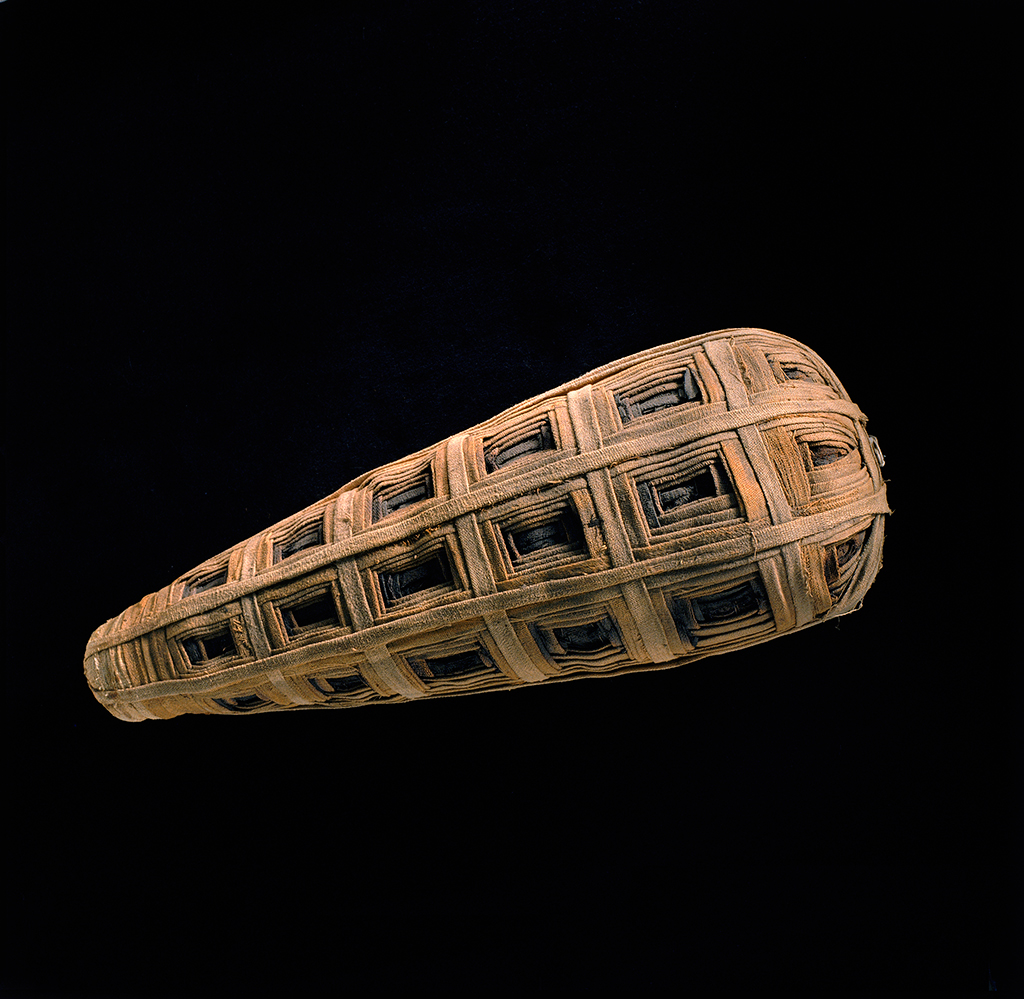
Generally, this kind of decoration is found on the ventral side of dogs, cats or birds of prey, and on the front of snake mummies or the back of crocodiles, but there are cases in which it also appears on the sides and back of ibis mummies.
English: Quarter-coloured coffer.
Snake mummy (London, British Museum, EA 35493). L. 21.3 cm. Provenance and date unknown. Photo: ©The Trustees of the British Museum. Pattern drawing showing a single complete coffer and an extension that explains the mode of weaving. Drawing by Valentina Poletto.
Subtype D3 – Diagonally coloured coffer
Generally, this type of decoration is found on the ventral side of dogs, cats (Fig. 35), birds of prey, or on the back of crocodiles, but it also appears on the sides and back of ibis mummies.
English: Diagonally coloured coffer.
a. Cat mummy (Turin, Museo Egizio, C. 2349/6). H. 35 cm, D. 22 cm. Provenance and date unknown. Photo: Museo Egizio, Turin. Pattern drawing by Valentina Poletto.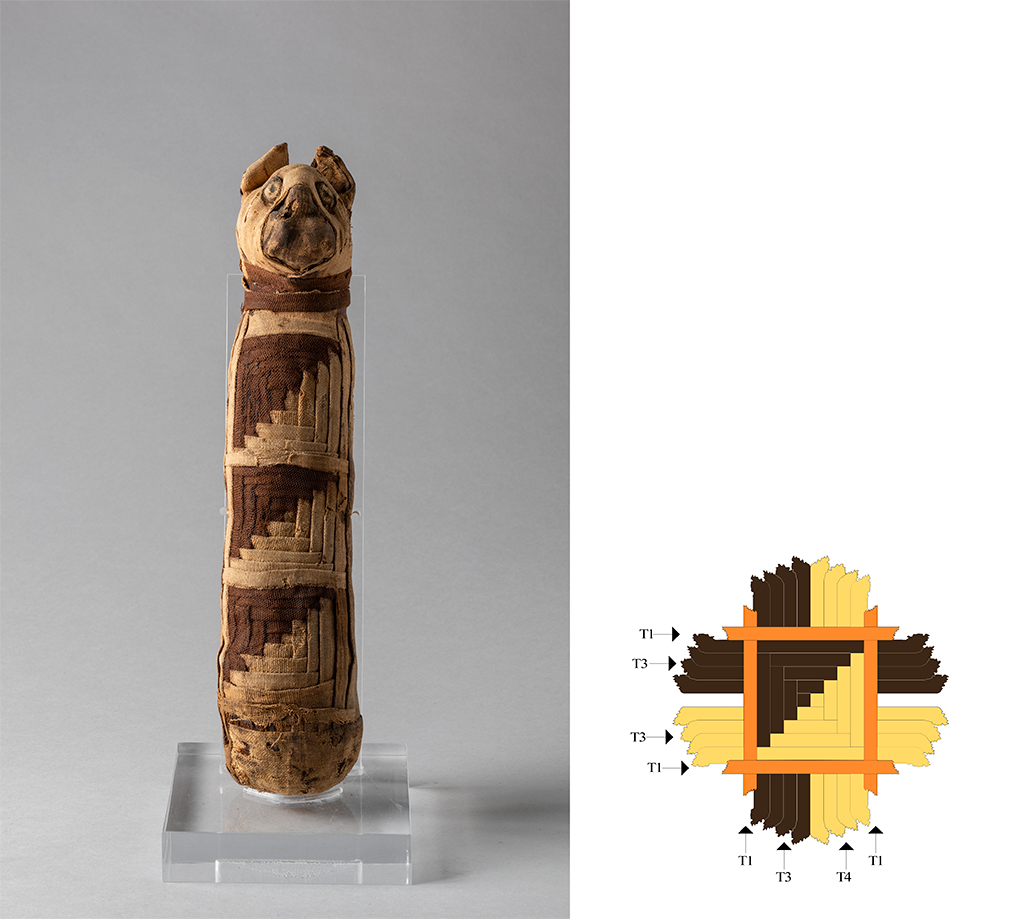
Generally, this sort of decoration is found on the ventral side of dogs, cats (Fig. 36) or birds of prey, or on the back of crocodiles, but there are cases in which it also appears on the sides and back of ibis mummies (Fig. 37).
English: Polychrome mirrored stepped pattern.
Cat mummy (Turin, Museo Egizio, C. 2349/5). H. 41 cm. Provenance and date unknown. Photo: Museo Egizio, Turin. Pattern drawing by Valentina Poletto.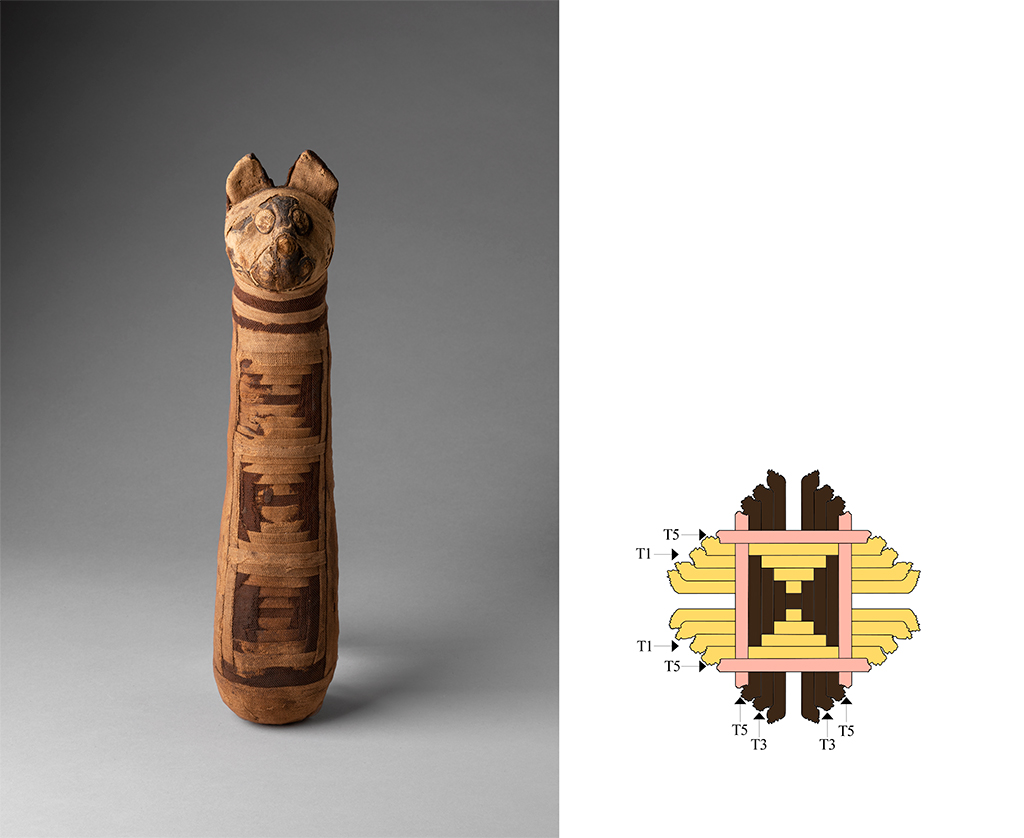
Ibis mummy (London, British Museum, EA 53937). L. 35.5 cm. Abydos. Date unknown. Photo: ©The Trustees of the British Museum. Pattern drawing by Valentina Poletto.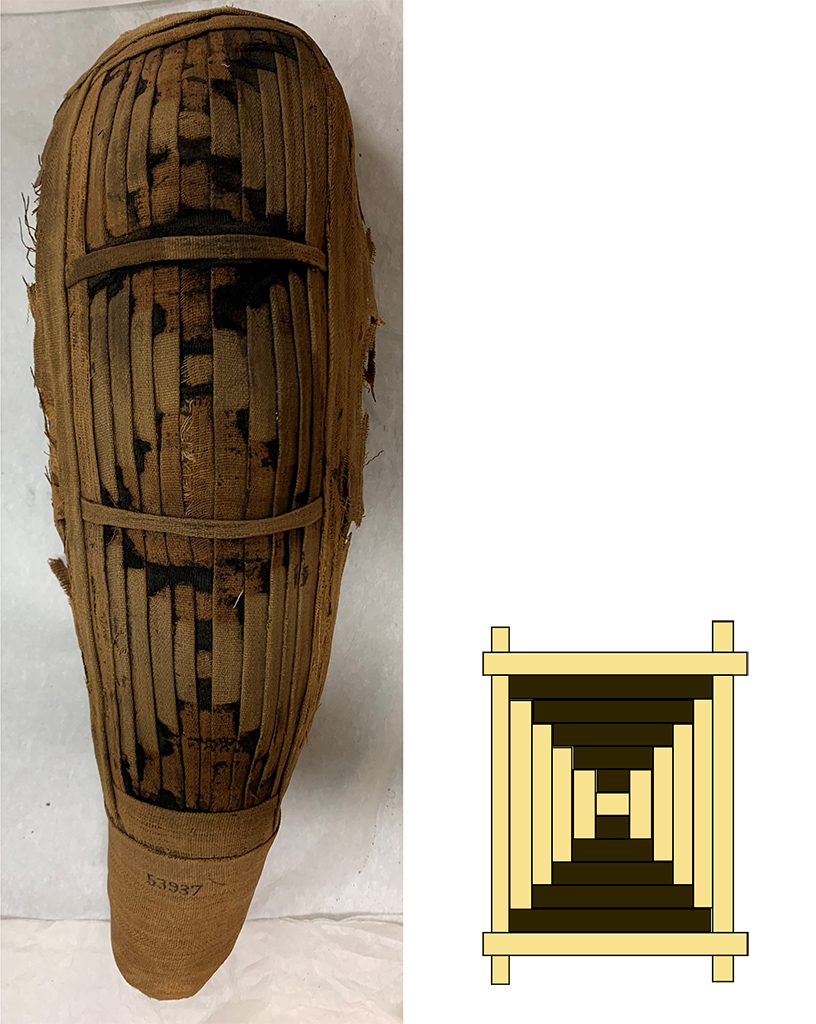
Generally, this type of decoration is found on the chest of cattle (Fig. 38), the ventral side of dogs, cats, birds of prey, or the back of crocodiles, but there are cases in which it also appears on the sides and back of ibis mummies.
English: Polychrome meander coffer.
Cattle mummy (Turin, Museo Egizio, C. 2343/1). L. 67 cm, W. 43 cm, H. 47 cm. Provenance unknown. 540-210 BC (14C of the textile). Photo: Museo Egizio, Turin. Pattern drawing by Valentina Poletto.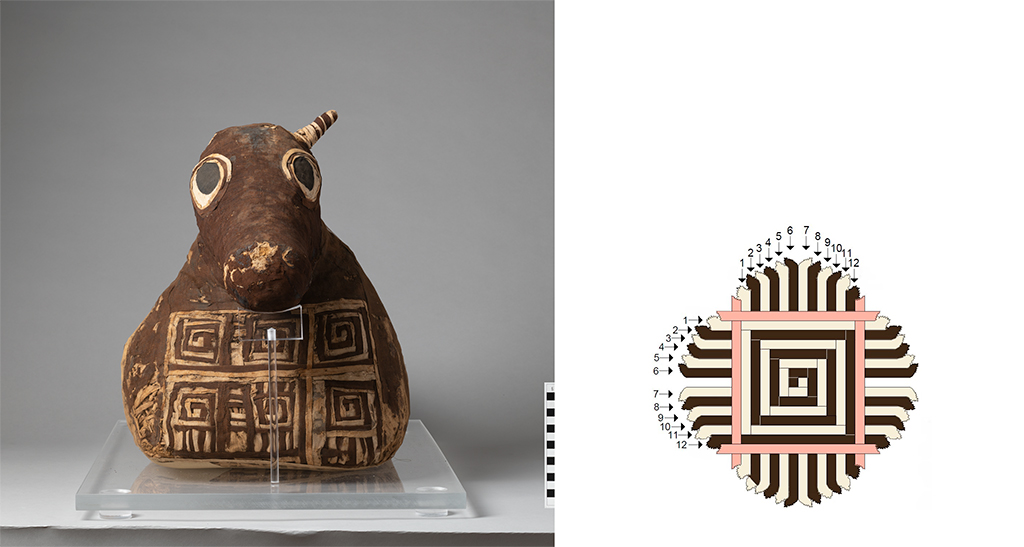
3.5. Type E – Hybrid technique
- ● Subtype E1: hybrid diamond coffer
- ● Subtype E2: D-shape.
Subtype E1 – Hybrid diamond coffer
The diamond coffer is considered a hybrid type as it is achieved by combining the features of Type B with those of Type D.
The pattern, as in Type D, is achieved through the orthogonal interweaving of vertical and horizontal bandages (with the edges folded only on one side), arranged in diamond-shaped coffers. In some instances, the diamond pattern is repeated on the dorsal side as well. Each coffer is framed and separated from adjacent ones by a bandage (folded on both sides), sometimes in a contrasting colour, which serves both to enhance the design and to structurally maintain the decoration in place.
Thus, the bandages are not arranged in a plain and orthogonal structure, as in Type D, but each bandage is entirely wrapped around the body in a continuous manner, as in Type B.
This type is usually found on the ventral surface of animals like raptors (Fig. 39), cats (Fig. 40), dogs, etc., though it may be repeated over the entire surface of the animal.
English: Hybrid diamond coffer (Type B+D).
Raptor mummy (Turin, Museo Egizio, P. 1460/13). H. 22.3 cm. Provenance unknown. 390-170 BC (14C of the textile). Photo: Museo Egizio, Turin. Pattern drawing by Valentina Poletto.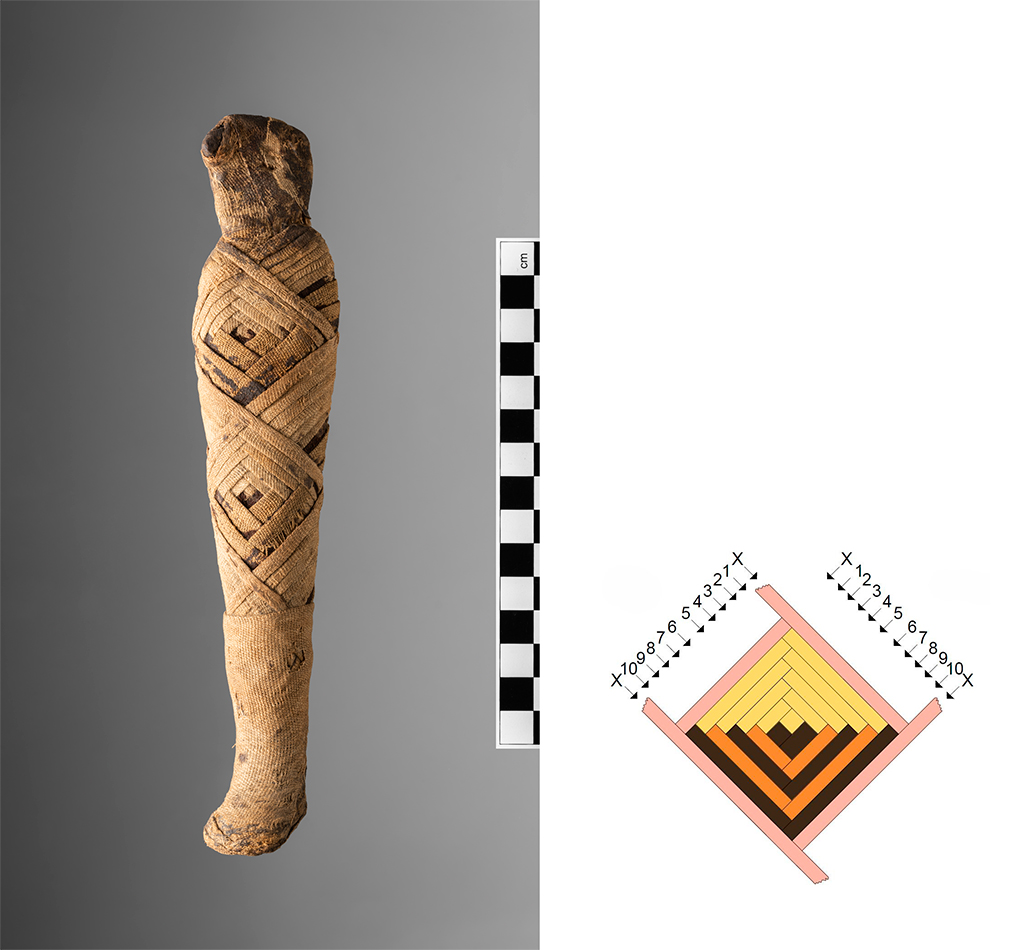
Cat mummy (London, British Museum, EA 55614). L. 45.5 cm. Provenance and date unknown. Photo: ©The Trustees of the British Museum.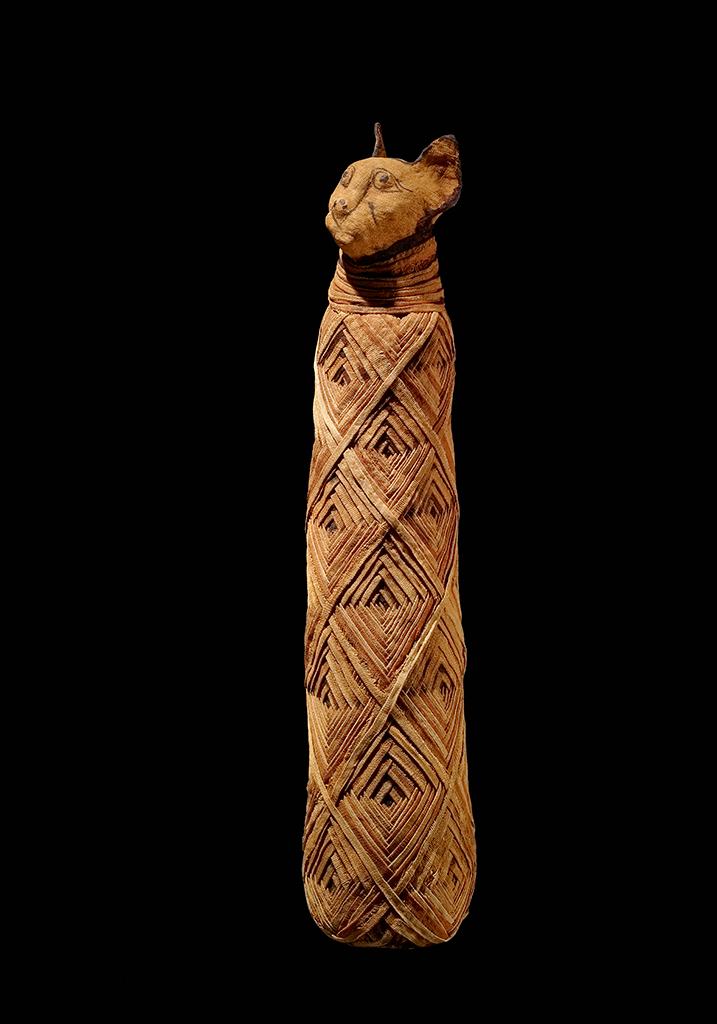
Subtype E2 – D-shaped
English: Elongated D-shaped herringbone polychrome motif.
Ibis mummy (Turin, Museo Egizio, S. 11029). L. 37.6 cm, W. 12.2 cm. Asyut. Probably 5th to 1st century BC. Photos: Museo Egizio, Turin.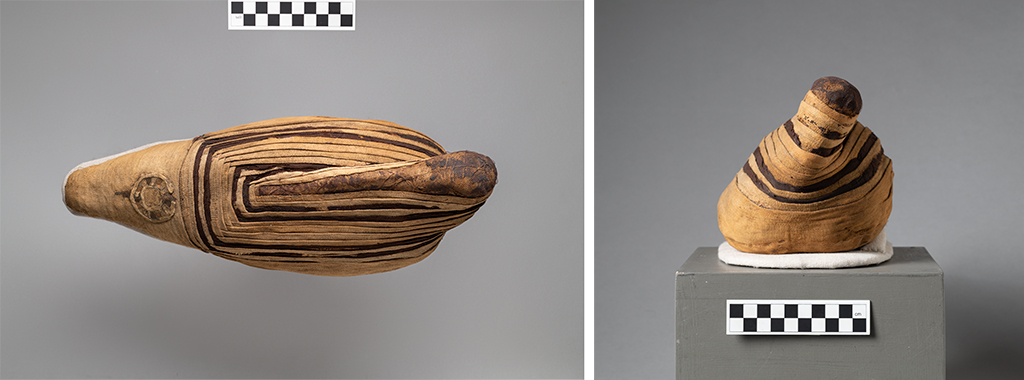
Annex 1: Typology of shapes
Rectangular (Fig. 42)
Subtype D2. Snake mummy (London, British Museum, EA 35493). L. 21.3 cm, W. 9.5 cm. Provenance unknown. Ptolemaic Period. Photo: ©The Trustees of the British Museum.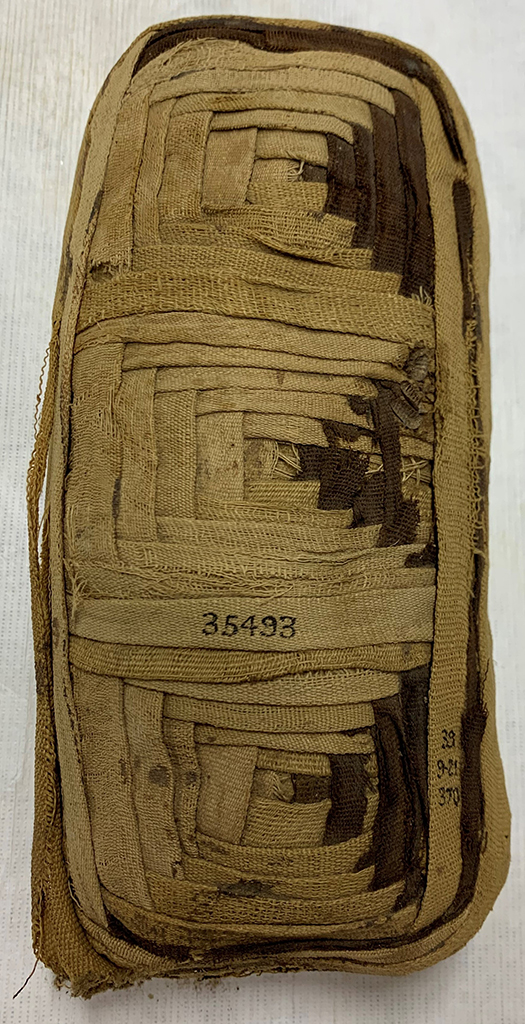
Square (or square with rounded corners) (Fig. 43)
Subtype A2. Shrew mummy with an edging bandage (TT11-TT12, no. 6492). L. 7 cm, W. 5.1 cm. Photo by Salima Ikram. Courtesy TT11-TT12 Djehuty Project.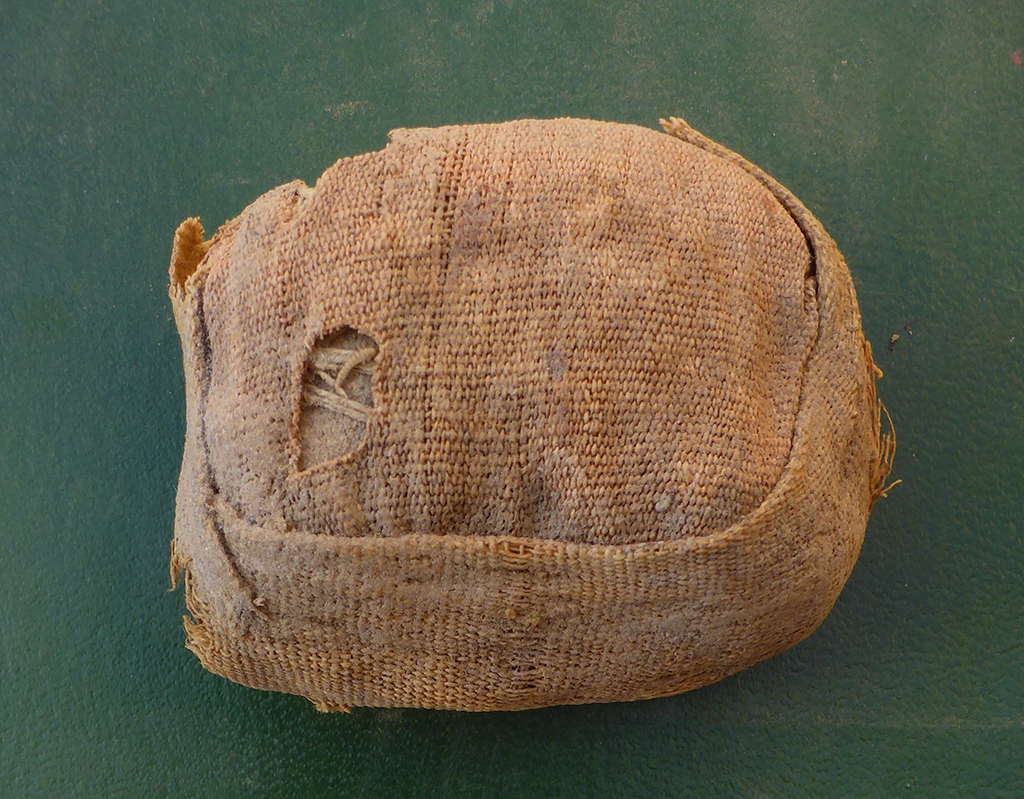
Subtype A3. Reptile mummy (London, British Museum, EA 52921). D. 8.5 cm. Abydos. Ptolemaic Period. Photo: ©The Trustees of the British Museum.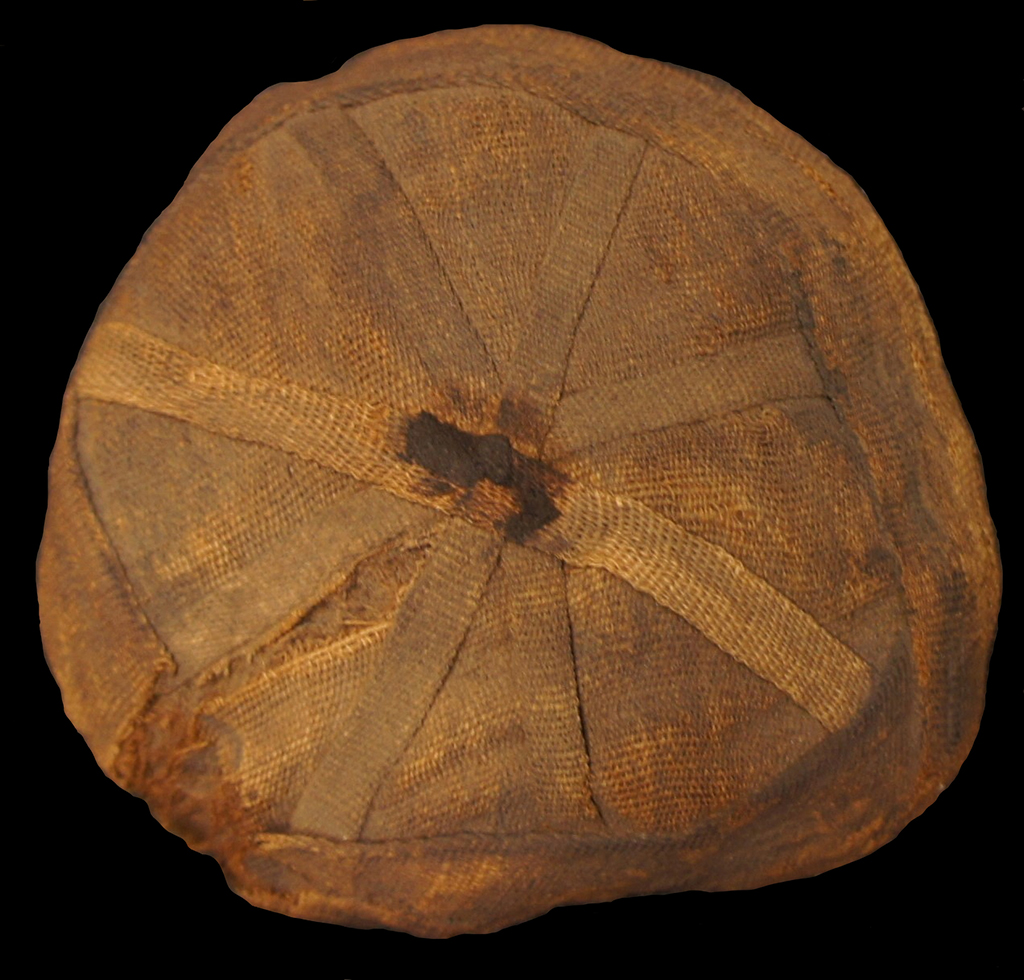
Teardrop (flattened) (Fig. 45)
Subtype B4. Ibis mummy (London, British Museum, EA 67149). L. 47 cm. Saqqara. Date unknown. Photo: ©The Trustees of the British Museum.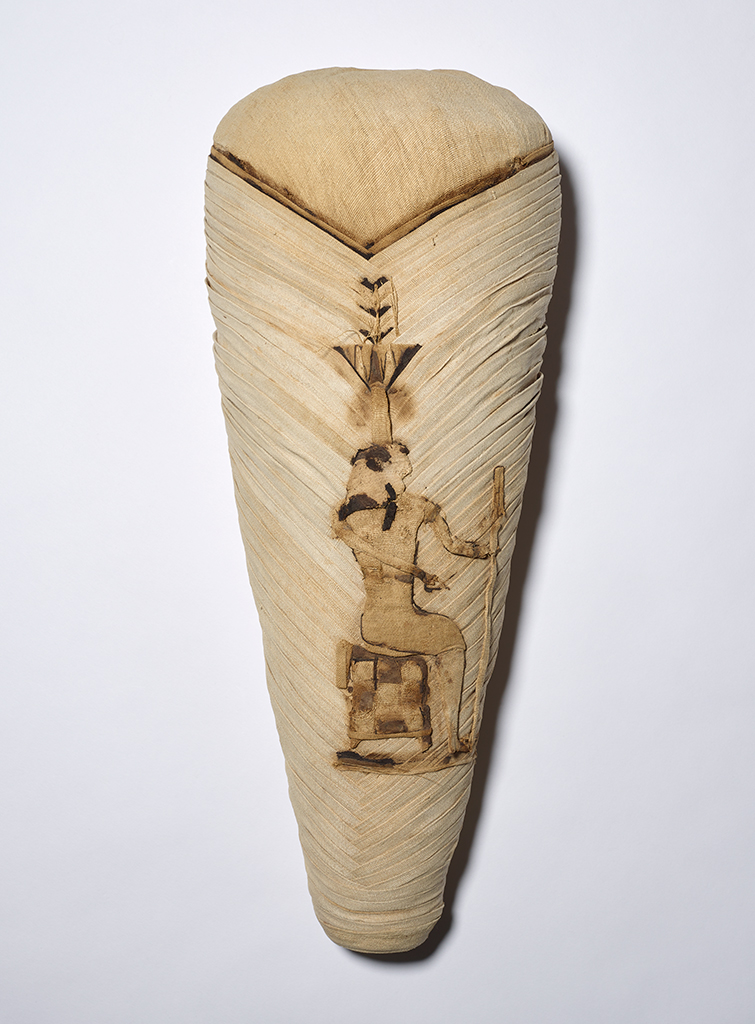
Bundle of linen found in an ibis cemetery (Cairo, Egyptian Museum CG 29872). L. 37.3 cm, W. 11.2 cm. Photo: ©Egyptian Museum, Cairo, Animal Mummy Project. Photo by Anna-Marie Kellen.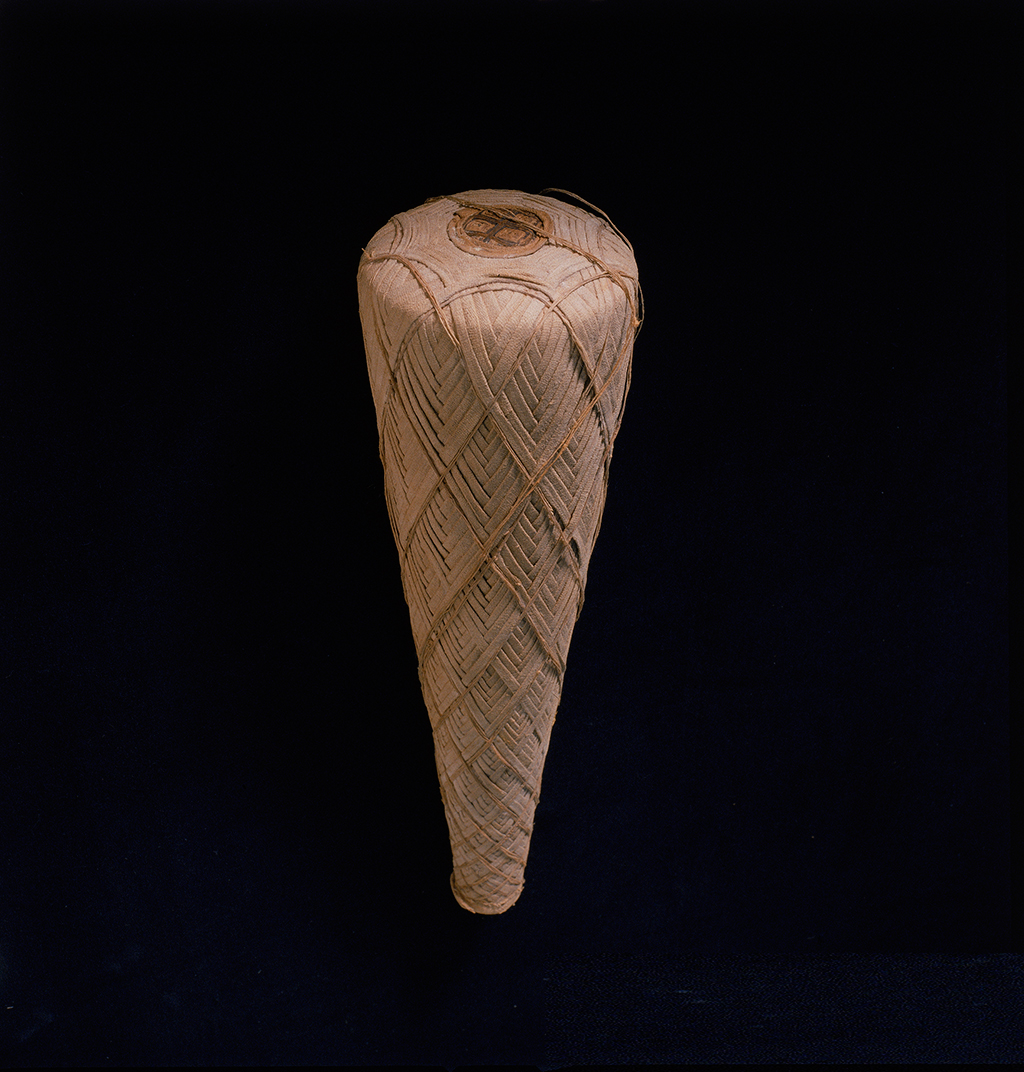
Reclining ibis with head and beak in relief (Fig. 47)
Subtype E2. Ibis mummy (Turin, Museo Egizio, S. 11029). L. 37.6 cm, W. 12.2 cm. Asyut. 5th to 1st century BC. Photo: Museo Egizio, Turin.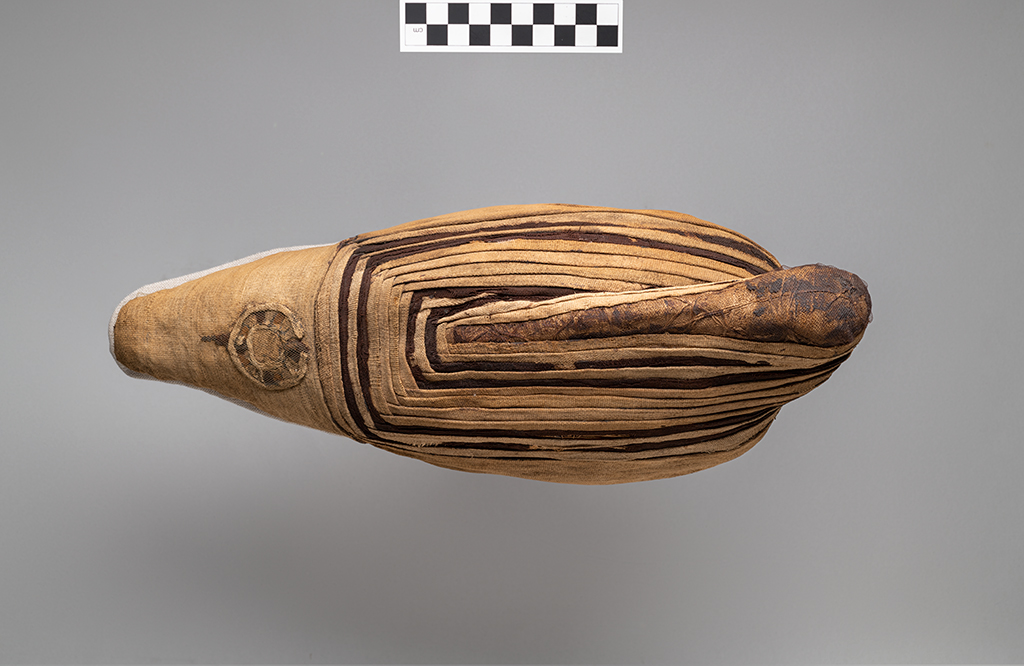
Cat mummy (Turin, Museo Egizio, C. 2349/3). L. 39 cm. Provenance and date unknown. Photo: Museo Egizio, Turin.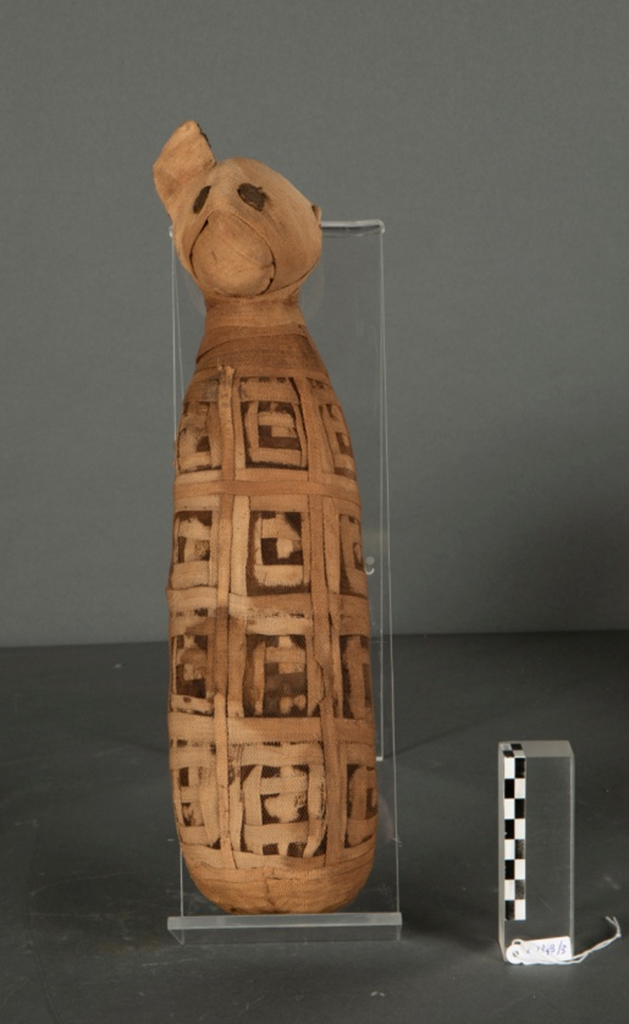
Cat mummy (Turin, Museo Egizio, P. 1442). L. 32 cm. Provenance and date unknown. Photo: Museo Egizio, Turin.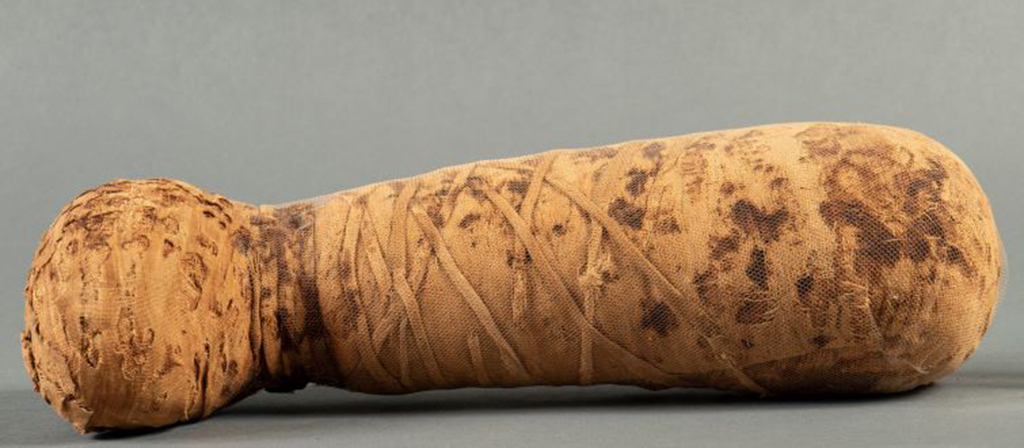
Ibis mummy (Cairo, Egyptian Museum, CG 29868). L. 68 cm. Abydos. Date unknown. Photo: ©Egyptian Museum, Cairo, Animal Mummy Project. Photo by Anna-Marie Kellen.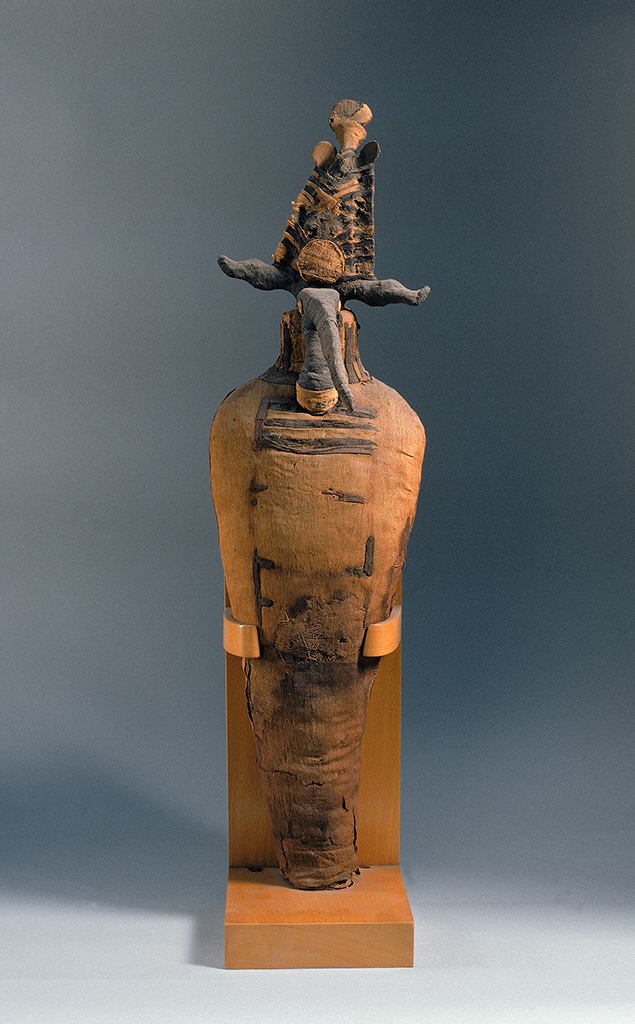
Animal form: standing (Fig. 51)
Cat mummy (Sharm el-Sheikh Museum, number pending). L. 36 cm. Bubasteion, Saqqara. Probably Ptolemaic Period. Photo: ©Ministry of Tourism and Antiquities’ Press Office. Photo by Ayman Damarany.
Subtype D6. Cattle mummy (Turin, Museo Egizio, C. 2343/1). L. 67 cm, W. 43 cm, H. 47 cm. Provenance unknown. 540-210 BC. Photo: Museo Egizio, Turin.
Anthropomorphic mummiform (Fig. 53)
Subtype E1. Raptor mummy (Turin, Museo Egizio, P. 1460). L. 22.3 cm, W. 3.7 cm. Provenance and date unknown. Photo: Museo Egizio, Turin.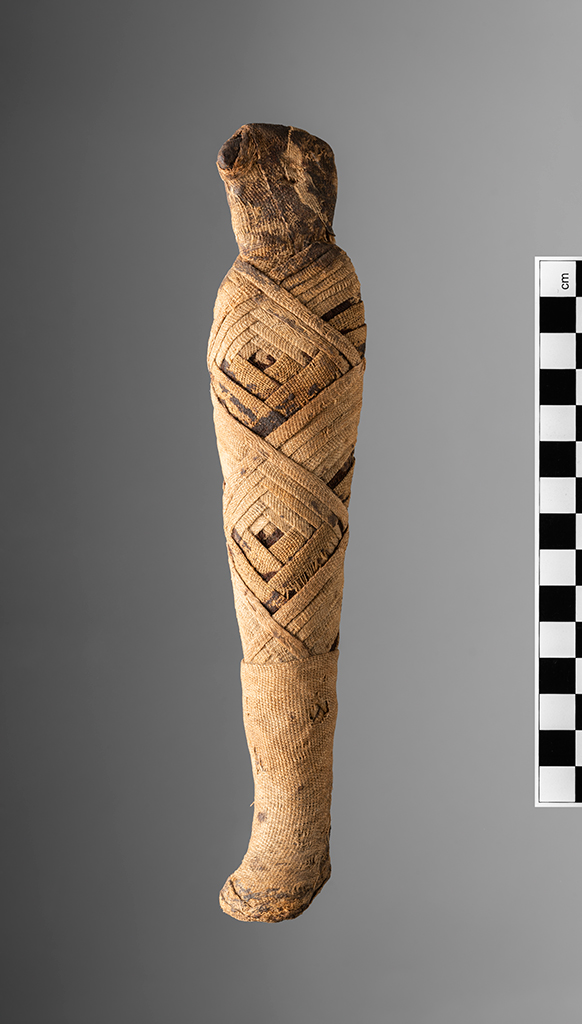
Annex 2: Glossary
Tabby weave. Drawing by Pieter Collet, after Kemp and Vogelsang-Eastwood, Amarna, 2001, fig. 4.4, p. 92.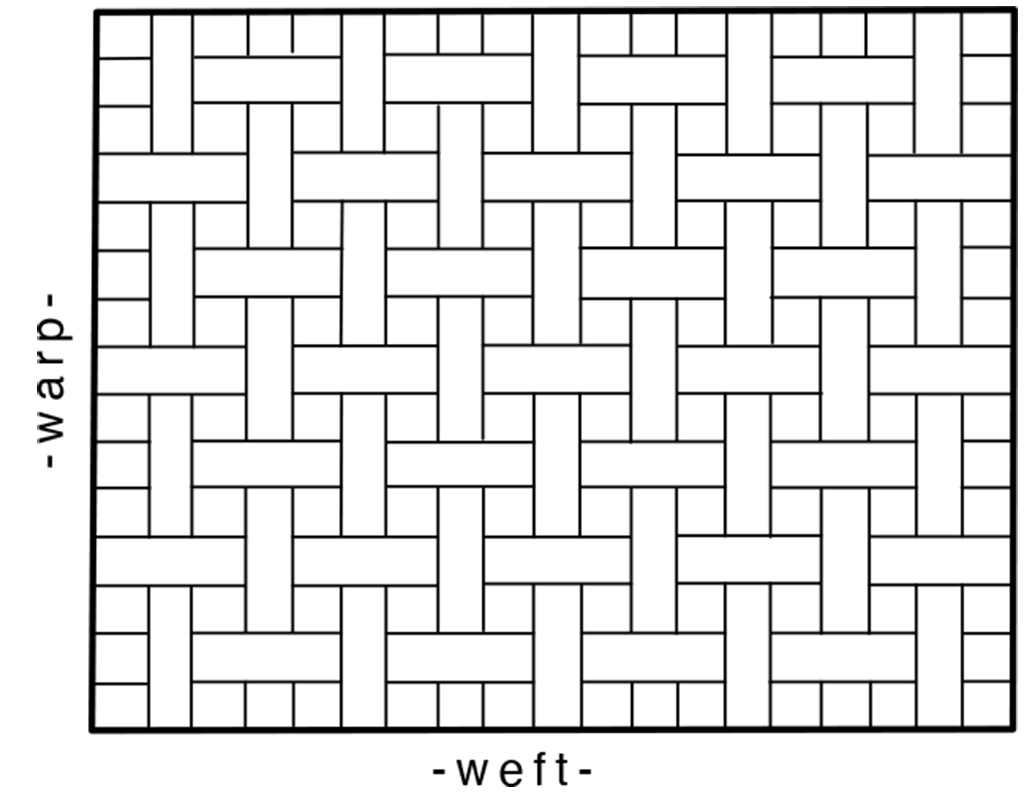
Basket weave: (also called extended weave) a tabby weave in which warp ends or weft picks, or both, move in groups of two or, more rarely, three (Fig. 55). The pairing can be applied to both warp and weft sets, or just to one of them. In the latter case the term half-basket is used (Fig. 56).
Basket weave or extended weave. Drawing by Pieter Collet, after Kemp and Vogelsang-Eastwood, Amarna, 2001, fig. 4.5, p. 93.
Half-basket weave; Drawing by Pieter Collet, after Kemp and Vogelsang-Eastwood, Amarna, 2001, fig. 4.6, p. 93.
The visual effect is that of a series of diagonal lines, which can have an “S” or “Z” direction.26
Twill. Drawing by Pieter Collet, after Burnham, Textile Terminology, 1980, pp. 154–55.
Chevron twill: any form of twill in which the direction of the diagonal lines is reversed over groups of warps or wefts. It is a warp chevron twill, or herringbone twill, when the axes of the chevrons lie in the direction of the warp (Fig. 58). In this case, the V-shaped motif appears vertical and it can be defined as a warp chevron twill. 28
Chevron twill. Drawing by Pieter Collet, after Burnham, Textile Terminology, 1980, p. 23.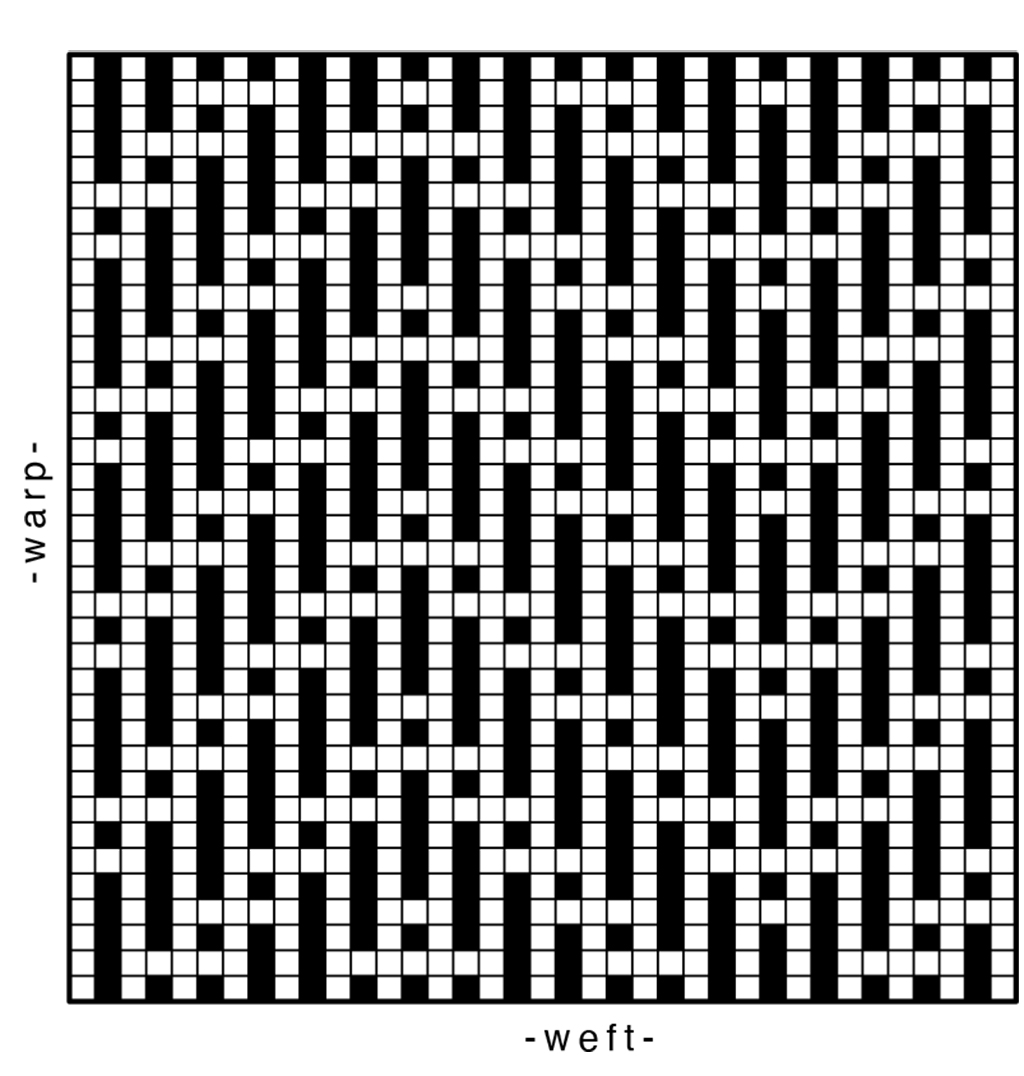
Bibliography
Boessneck, Joachim (ed.), Tuna el-Gebel I: die Tiergalerien (HÄB 24), Hildesheim 1987.
Borla, Matilde and Salima Ikram, “Reflections on Wrapping: Shapes, Patterns, Provenance, and Periods”, in: Salima Ikram, Sara Aicardi and Federica Facchetti (eds.), The Animal Mummies of the Museo Egizio, Turin (Studi del Museo Egizio 5), Modena 2024, pp. 43–52.
Bosch-Puche, Francisco and Salima Ikram, “The Archaeology of the Area: An Overview”, in: Christina Di Cerbo and Richard Jasnow (eds.), On the Path to the Place of Rest: Demotic Graffiti Relating to the Ibis and Falcon Cult from the Spanish Mission at Dra Abu el-NagaꜤ (TT 11, TT 12, Tomb –399–, and Environs), Atlanta (GA) 2022, pp. 17–35.
Burnham, Dorothy K., Textile Terminology: Warp and Weft, Toronto 1980.
Charron, Alain, “Massacres d’animaux à la Basse Époque”, RdE 41 (1990), pp. 209–13.
Charron, Alain, “Les animaux et le sacré dans l’Égypte tardive, fonctions et signification”, AEPHE 105 (1996), pp. 517–19.
Charron, Alain, “Les Ptolémées et les animaux sacrés”, in: Jean-Yves Empereur (ed.), La gloire d’Alexandrie (catalogue de l’exposition, Paris, musée du Petit Palais, 7 mai – 26 juillet 1998), Paris 1998, pp. 19–98.
Charron, Alain, “Les animaux sacrés, du sauvage à l’élevage”, in: Magali Massiera, Bernard Mathieu and Frédéric Rouffet (eds.), Apprivoiser le sauvage / Taming the Wild, Montpellier 2015, pp. 67–92.
Davies, Sue and Harry S. Smith, The Sacred Animal Necropolis at North Saqqara: The Falcon Complex and Catacomb. The Archaeological Report (EES-ExcMem 73), London 2005.
Davies, Sue, Harry S. Smith and Kenneth J. Frazer, The Sacred Animal Necropolis at North Saqqara: The Mother of Apis and Baboon Catacombs. The Archaeological Report (EES-ExcMem 73), London 2006.
Dodson, Aidan, “Bull Cults”, in: Salima Ikram (ed.), Divine Creatures: Animal Mummies in Ancient Egypt, Cairo 20052, pp. 72–105.
von den Driesch, Angela and Joachim Boessneck, “Krankhaft veränderte Skelettreste von Pavianen aus altägyptischer Zeit”, TierPrax 13 (1985), pp. 367–72.
von den Driesch, Angela and Dieter Kessler, “Tiermumien aus dem altägyptischen Friedhof von Tuna el-Gebel”, Einsichten 1 (1994), pp. 31–34.
von den Driesch, Angela, Dieter Kessler and Joris Peters, “Mummified Baboons and Other Primates from the Saitic-Ptolemaic Animal Necropolis of Tuna el-Gebel, Middle Egypt”, in: Gisela Grupe and Joris Peters (eds.), Conservation Policy and Current Research (DOAB 2), Rahden 2004, pp. 231–78.
von den Driesch, Angela, Dieter Kessler, Frank Steinmann, Véronique Berteaux and Joris Peters, “Mummified, Deified and Buried at Hermopolis Magna – the Sacred Birds from Tuna el-Gebel, Middle Egypt”, ÄgLev 15 (2005), pp. 203–44.
von den Driesch, Angela and Joris Peters, “Ruhende Götter oder Ibisnahrung? Die Fischfunde aus der Tiernekropole von Hermopolis Magna bei Tuna el-Gebel (Mittelägypten)”, in: Mélanie C. Flossmann-Schütze, Maren Goecke-Bauer, Friedhelm Hoffmann, Andreas Hutterer, Katrin Schlüter, Alexander Schütze and Martina Ullmann (eds.), Kleine Götter – Grosse Götter: Festschrit für Dieter Kessler zum 65. Geburtstag (TeG 4), Hildesheim 2013, pp. 105–12.
Emery, Walter B., “Preliminary Report on the Excavations at North Saqqâra 1964–5”, JEA 51 (1965), pp. 3–8.
Emery, Walter B., “Preliminary Report on the Excavations at North Saqqâra 1965–6”, JEA 52 (1966), pp. 3‒8.
Emery, Walter B., “Preliminary Report on the Excavations at North Saqqâra 1966–7”, JEA 53 (1967), pp. 141‒45.
Emery, Walter B., “Preliminary Report on the Excavations at North Saqqara, 1968”, JEA 55 (1969), pp. 31‒55.
Emery, Walter B., “Preliminary Report on the Excavations at North Saqqara 1968-1969”, JEA 56 (1970), pp. 5‒11.
Emery, Walter B., “Preliminary Report on the Excavations at North Saqqara 1969-1970”, JEA 57 (1971), pp. 3‒13.
Geoffroy Saint-Hilaire, Etienne, “Description de deux crocodiles qui existent dans le Nil, comparés au crocodile de Saint-Domingue”, AMHN 10 (1807), pp. 67–86.
Geoffroy Saint-Hilaire, Etienne, Description de l’Égypte ou Recueil des observations et des recherches qui ont été faites en Egypte pendant l’expédition de l’armée française, Histoire naturelle I, Paris 1809.
Hekkala, Evon R., Matthew L. Aardema, Apurva Narechania and Oliver Smith, “The Secrets of Sobek – A Crocodile Mummy Mitogenome from Ancient Egypt”, JAS–Rep 33 (2020).
Hekkala, Evon R., Matthew H. Shirley, George Amato, James D. Austin, Suellen Charter, John Thorbjarnarson, Kent A. Vliet, Marlys L. Houck, Rob Desalle and Michael J. Blum, “An Ancient Icon Reveals New Mysteries: Mummy DNA Resurrects a Cryptic Species Within the Nile Crocodile”, MOL ECOL 20/20 (2011), pp. 4199–215.
Ikram, Salima, Choice Cuts: Meat Production in Ancient Egypt (OLA 69), Leuven 1995.
Ikram, Salima, “The Animal Mummy Project”, KMT 12/4 (2001), pp. 18–25.
Ikram, Salima, A Zoo for Eternity: Animal Mummies in the Cairo Museum, Cairo 2004.
Ikram, Salima “Victual, Ritual, or Both? Food Offerings from the Funerary Assemblage of Isitemkheb”, SEP 1 (2004), pp. 87–92.
Ikram, Salima (ed.), Divine Creatures: Animal Mummies in Ancient Egypt, Cairo 20052.
Ikram, Salima, “The Loved Ones: Egyptian Animal Mummies as Cultural and Environmental Indicators”, in: Hijlke Buitenhuis, Alice M. Choyke, Louise Martin, László Bartosiewicz and Marjan Mashkour (eds.), Archaeozoology of the Near East VI: Proceedings of the Sixth International Symposium on the Archaeozoology of Southwestern Asia and Adjacent Areas (ARC-Publicaties 123), Groningen 2005, pp. 240–48.
Ikram, Salima, “The Forgotten Dead: Animal Burials in the Theban Necropolis”, in: Zahi Hawass, Támas A. Bács and Gábor Schreiber, Proceedings of the Colloquium on Theban Archaeology at the Supreme Council of Antiquities, November 5, 2009, Cairo 2001, pp. 73–75.
Ikram, Salima, “Divine Creatures: Animal Mummies in Ancient Egypt”, in: Salima Ikram (ed.), Divine Creatures: Animal Mummies in Ancient Egypt, Cairo 20052, pp. 1–16.
Ikram, Salima, “Speculations on the Role of Animal Cults in the Economy of Ancient Egypt”, in: Magali Massiera, Bernard Mathieu and Frédéric Rouffet (eds.), Apprivoiser le sauvage – Taming the Wild: Glimpses on the Animal World in Ancient Egypt, Montpellier 2015, pp. 211–28.
Ikram, Salima, “Shedding New Light on Old Corpses: Developments in the Field of Animal Mummy Studies”, in: Stéphanie Porcier, Salima Ikram and Stéphane Pasquali, Creatures of Earth, Water and Sky: Essays on Animals in Ancient Egypt and Nubia, Leiden 2019, pp. 179–91.
Ikram, Salima and Nasry Iskander, Catalogue Général of the Egyptian Museum: Non-Human Remains, Cairo 2002.
Ikram, Salima and Abeer Helmi, “The History of the Collection of the Animal Mummies at the Egyptian Museum, Cairo”, in: Zahi Hawass and Lyla Pinch-Brock (eds.), Egyptology at the Dawn of the Twenty-first Century: Proceedings of the Eighth International Congress of Egyptologists Cairo, 2000, Cairo and New York 2003, pp. 563–68.
Ikram, Salima and Louise Bertini, “The Faunal Material”, in: Paul T. Nicholson (ed.), The Catacombs of Anubis at North Saqqara: An Archaeological Perspective, Leuven 2021, pp. 135–88.
Ikram, Salima, Sara Aicardi and Federica Facchetti (eds.), The Animal Mummies of the Museo Egizio, Turin (Studi del Museo Egizio 5), Modena 2024.
Kemp, Barry J. and Gillian Vogelsang-Eastwood (eds.), The Ancient Textile Industry at Amarna (MEES 68), London 2001.
Kessler, Dieter and Abd el Halim Nur el-Din, “Tuna al-Gebel: Millions of Ibises and Other Animals”, in: Salima Ikram (ed.), Divine Creatures: Animal Mummies in Ancient Egypt, Cairo 20052, pp. 120–63.
Lortet, Louis and Claude Gaillard, La faune momifiée de l’ancienne Egypte, 2 Vols. (AMHNL), Lyon 1903-1909.
Nicholson, Paul T., Salima Ikram and Steve Mills, The Catacombs of Anubis at North Saqqara: An Archaeological Perspective (BMPES 12), Leuven 2021.
Porcier, Stéphanie, Pascale Richardin, Gaëtan Louarn, Salima Ikram and Didier Berthet, “Datations par le carbone 14 de 63 momies animales du musée des Confluences à Lyon (France)”, in: Stéphanie Porcier, Salima Ikram and Stéphane Pasquali (eds.), Creatures of Earth, Water and Sky: Essays on Animals in Ancient Egypt and Nubia, Leiden 2019, pp. 283–92.
Pubblico, Maria Diletta, “A Study of Egyptian Animal Mummy Styles (SEAMS) Project”, in: Rosanna Pirelli, Maria Diletta Pubblico and Salima Ikram (eds.), Animals in the Religion, Economy, and Daily Life of Ancient Egypt and Beyond (Studi Africanistici – Serie Egittologica 4), Naples 2023, pp. 331–48.
Pubblico, Maria Diletta and Cinzia Oliva, “Les cinq momies de chat de la Società africana d’Italia (SAI) : nouvelles recherches, nouvelles découvertes”, in: Stéphanie Porcier, Salima Ikram and Stéphan Pasquali (eds.), Creatures of Earth, Water, and Sky: Essays on Animals in Ancient Egypt and Nubia, Leiden 2019, pp. 293–304.
Richardin Pascale, Stéphanie Porcier, Salima Ikram, Gaëtan Louarn and Didier Berthet, “Cats, Crocodiles, Cattle, and More: Initial Steps Toward Establishing a Chronology of Ancient Egyptian Animal Mummies”, Radiocarbon 59/2 (2017), pp. 595–607.
Smith, Harry S., A Visit to Ancient Egypt: Life at Memphis and Saqqara (c. 500–30 BC), Warminster 1974.
Smith, Harry S. and David G. Jeffreys, “The Sacred Animal Necropolis, North Saqqâra: 1975/6”, JEA 63 (1977), pp. 20–28.
Smith, Harry S., Carol A.R. Andrews and Sue Davies, The Sacred Animal Necropolis at North Saqqara: The Mother of Apis Inscription (EES-TE 14), London 2011.
Tomorad, Mladen, “The End of Ancient Egyptian Religion: The Prohibition of Paganism in Egypt from the Middle of the 4th to the Middle of the 6th Century A.D”, JES (S) IV (2015), pp. 147–64.
Tristant, Yann, Michel Baud and Alain Charron, “Abou Rawach, un site ressuscité”, Archéologia 481 (2010), pp. 58–59.
Waziry, Mostafa, Vestiges of Ancient Egypt: The Bubasteion Votive Cachette at Saqqara, Cairo and Houston 2003.
Notes
- For <sup>14</sup>C dating see Richardin et al., <i>Radiocarbon</i> 59/2 (2017); Porcier et al., in Porcier et al. (eds.), <i>Creatures of Earth</i>, 2019; Ikram et al. (eds.), <i>The Animal Mummies of the Museo Egizio</i>, 2024. Thus far, the limited <sup>14</sup>C carried out on animal mummies shows that the latest date to the middle of the 4th century, while texts from the Bucheum testify that the cult survived into the early 5th century, as noted by Dodson, in Ikram (ed.), <i>Divine Creatures</i>, 2005<sup>2</sup>. However, it is quite possible that the practice persisted into slightly later times as paganism persisted into the 6<sup>th</sup> century until Justinian closed the Isis temple at Philae and that of Sobek and Horus at Kom Ombo (for an overview of the documentation for the end of paganism in Egypt, see Tomorad, <i>JES (S)</i> IV [2015]).↑
- See Ikram, in Porcier et al. (eds.), <i>Creatures of Earth</i>, 2019 for a general overview and history of animal mummy studies.↑
- Geoffroy Saint-Hilaire, <i>AMHN</i> 10 (1807). In another publication he mentions five species, which remains discredited until now (Geoffroy Saint-Hilaire, <i>Description de l'Égypte</i>, pp. 243–63).↑
- Hekkala et al., <i>MOL ECOL</i> 20/20 (2011); Hekkala et al., <i>JAS–Rep</i> 33 (2020).↑
- Lortet and Gaillard, <i>La faune momifiée</i>, 1903-1909.↑
- For example, von den Driesch and Boessneck, <i>TierPrax</i> 13 (1985); Boessneck, <i>Tuna el-Gebel I</i>, 1987; von den Driesch and Kessler, <i>Einsichten</i> 1 (1994); von den Driesch et al., in Grupe and Peters (eds.), <i>Conservation Policy</i>, 2004; von den Driesch et al., <i>ÄgLev</i> 15 (2005); Kessler and Nur el-Din, in Ikram (ed.), <i>Divine Creatures</i>, 2005<sup>2</sup>; von den Driesch and Peters, in Flossmann-Schütze et al. (eds.), <i>Kleine Götter – Grosse Götter</i>, 2013.↑
- Emery, <i>JEA</i> 51 (1965); Emery, <i>JEA</i> 52 (1966); Emery, <i>JEA</i> 53 (1967); Emery, <i>JEA</i> 55 (1969); Emery, <i>JEA</i> 56 (1970); Emery, <i>JEA</i> 57 (1971).↑
- Smith, <i>A Visit to Ancient Egypt</i>, 1974; Smith and Jeffreys, <i>JEA</i> 63 (1977); Smith and Davies, <i>The Sacred Animal Necropolis</i>, 2005; Smith et al., <i>The Sacred Animal Necropolis</i>, 2006; Smith et al., <i>The Sacred Animal Necropolis</i>, 2011.↑
- Smith and Davies, <i>The Sacred Animal Necropolis</i>, 2005; Smith et al., <i>The Sacred Animal Necropolis</i>, 2006; Smith et al., <i>The Sacred Animal Necropolis</i>, 2011.↑
- Charron, <i>RdE</i> 41 (1990); Charron, <i>Les animaux et le sacré</i>, 1996; Charron, in Empereur (ed.), <i>La gloire d’Alexandrie</i>, 1998; Tristant et al., <i>Archéologia</i> 481 (2010); Charron, in Massiera et al., <i>Apprivoiser le sauvage</i>, 2015, to mention but a few publications.↑
- For example, Ikram, <i>Choice Cuts</i>, 1995, Appendix II; Ikram, in Buitenhuis et al. (eds.), <i>Archaeozoology of the Near East</i>, 2005; Ikram, in Hawass et al. (eds.), <i>Proceedings of the Colloquium</i>, 2011; Ikram, in Ikram (ed.), <i>Divine Creatures</i>, 2015; Ikram, in Massiera et al. (eds.), <i>Apprivoiser le sauvage</i>, 2015; Ikram, in Porcier et al. (eds.), <i>Creatures of Earth</i>, 2019; Ikram et al., in Nicholson et al. (eds.), <i>The Catacombs of Anubis</i>, 2021.↑
- Ikram, <i>KMT</i> 12/4 (2001); Ikram and Helmi, in Hawass and Pinch-Brock (eds.), <i>Egyptology at the Dawn</i>, 2003; Ikram, <i>A Zoo for Eternity</i>, 2004; Ikram and Iskander, <i>Catalogue Général</i>, 2002; Ikram (ed.), <i>Divine Creatures</i>, 2005<sup>2</sup>.↑
- See Ikram, in Porcier et al. (eds.), <i>Creatures of Earth</i>, 2019 for an overview, and the bibliography in Ikram, in Massiera et al. (eds.), <i>Apprivoiser le sauvage</i>, 2015. For recent work on animal catacombs, see Nicholson et al., <i>The Catacombs of Anubis</i>, 2021.↑
- A prospective project to create a database that will focus on this is being launched: see Pubblico, in Pirelli et al. (eds.), <i>Animals in the Religion, Economy, and Daily Life</i>, 2023.↑
- Emery, <i>JEA</i> 53 (1967), p. 4.↑
- This paper will not focus on how the wrappings were constructed – some discussions of this are presented in Ikram et al. (eds.), <i>The Animal Mummies of the Museo Egizio</i>, 2024.↑
- Ikram, <i>Choice Cuts</i>, 1995, pp. 237–96; Ikram, <i>SEP</i> 1 (2004); Ikram, <i>Divine Creatures</i>, 2005<sup>2</sup>.↑
- Bosch-Puche and Ikram, in Di Cerbo and Jasnow (eds.), <i>On the Path to the Place of Rest</i>, 2022.↑
- Lortet and Gaillard, <i>La faune momifiée</i>, 1903, pp. 185–87.↑
- Lortet and Gaillard, <i>La faune momifiée</i>, 1903, pp. 78–82; Ikram and Iskander, <i>Catalogue général</i>, 2002, p. 11.↑
- The authors are grateful to the various museums (mentioned in the text) for their assistance and support, to J.M. Galán for access to TT 11, and to Federico Poole and the anonymous reviewers, whose remarks made us rethink our categories and achieve greater clarity.↑
- Waziry, <i>Vestiges of Ancient Egypt</i>, 2023, figs. 24, 26, 36.↑
- See Pubblico and Oliva, in Porcier et al. (eds.), <i>Creatures of Earth</i>, 2019, notably p. 298, fig. 6.↑
- Also see Borla and Ikram, in Ikram et al. (eds.), <i>The Animal Mummies of the Museo Egizio</i>, 2024.↑
- Kemp and Vogelsang-Eastwood, <i>Amarna</i>, 2001, pp. 92–93.↑
- Burnham, <i>Textile Terminology</i>, 1980, pp. 154–55.↑










